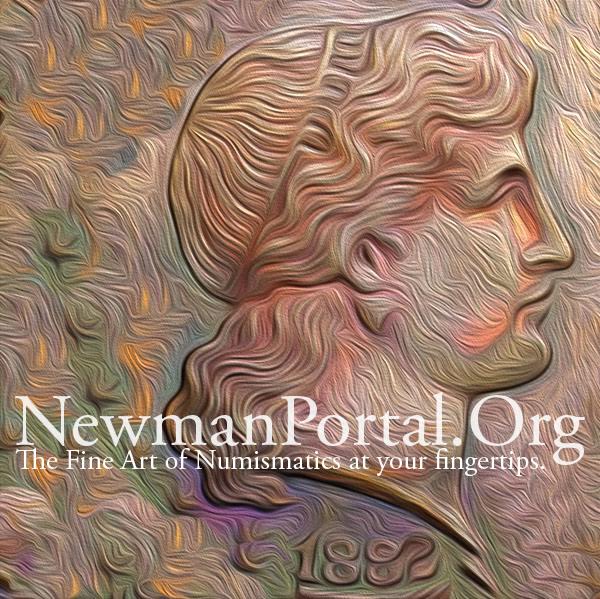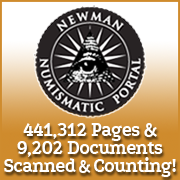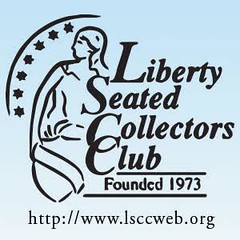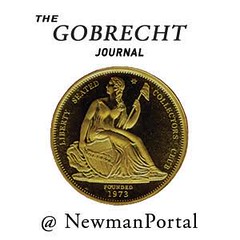
About UsThe Numismatic Bibliomania Society is a non-profit organization devoted to the study and enjoyment of numismatic literature. For more information please see our web site at coinbooks.org SubscriptionsThose wishing to become new E-Sylum subscribers (or wishing to Unsubscribe) can go to the following web page link MembershipThere is a membership application available on the web site Membership Application To join, print the application and return it with your check to the address printed on the application. Print/Digital membership is $40 to addresses in the U.S., and $60 elsewhere. A digital-only membership is available for $25. For those without web access, write to: Terry White, Treasurer AsylumFor Asylum mailing address changes and other membership questions, contact Terry at this email address: terrywhite5475@yahoo.com SubmissionsTo submit items for publication in The E-Sylum, just Reply to this message, or write to the Editor at this address: whomren@gmail.com BUY THE BOOK BEFORE THE COINSale Calendar |
- WAYNE'S WORDS: THE E-SYLUM DECEMBER 18, 2016
- MORE KOLBE & FANNING’S 2017 NEW YORK HIGHLIGHTS
- BOOK PLANNED ON VIENNA PHILHARMONIC COIN
- NEWMAN PORTAL ADDS CONNECTICUT MINT ACCOUNT BOOKS
- MINT COLLECTION ACQUISITIONS RESEARCH
- M. H. BOLENDER AUCTION SALE CATALOGS
- THE CHASE MANHATTAN BANK MONEY MUSEUM
- MORE ON THE MYSTERY CATALOG OF ENGLISH COINS
- NOTES FROM E-SYLUM READERS: DECEMBER 18, 2016
- TO INSCRIBE OR NOT TO INSCRIBE
- THE 1950 AMERICAN LEGION SCHOOL AWARD MEDAL
- JOSEPH EMILE RENIER (1887-1966)
- VOCABULARY TERM: DIE VAULT
- WILLIAM ENGLISH MICKLE (1846-1920)
- WALDO NEWCOMER BANK STOCK CERTIFICATE
- AUDIO: Q&A WITH LEROY VAN ALLEN
- THOSE “SOFT HUNDRED DOLLAR BILLS”
- MORE ON HIDDEN PROPAGANDA IN CHINESE BANKNOTES
- "1600" SMARTPHONE APP TRANSFORMS $1 BILL
- WAYNE'S NUMISMATIC DIARY: DECEMBER 18, 2016
- GOLDBERG ANCIENT JEWISH COINS 2017 NYINC SALE
- NEWMAN COLLECTION COLONIAL CURRENCY MONOGRAMS
- LAWSUIT DETAILS ISLAMIC STATE COIN SALES
- MACNEIL'S STANDING LIBERTY QUARTER BRONZE CAST
- 2014 'MULE' BRITANNIA ERROR £2 BULLION COINS
- PILOT LUIS PARDO'S SHACKLETON EXPEDITION MEDALS
- CLYDESDALE BANK NOTES
- VENEZUELA WITHDRAWS LARGEST BANKNOTE
- AUSTRALIA MULLS ELIMINATION OF $100 BANKNOTE
- ARTIST SPENDS BILL ENGRAVED WITH MICRO-PORTRAIT
- ARTIST ENGRAVED QUEEN'S PORTRAIT ON PINHEAD
- LEIDMAN'S 1916 MCKINLEY GOLD DOLLAR HUNT
- COUNTERFEITERS IN UNALASKA, ALASKA
- WANTED: COLD CALLING PHONE POUNDERS
- MORE AMAZING COIN STACKS
- HAPPY CHRISTMAS BOOK FLOOD
- CHARLES DICKENS: A CHRISTMAS CAROL
- NUMISMATIC REFERENCES IN A CHRISTMAS CAROL
- A CHRISTMAS COIN CAROL
Click here to access the complete archive
To comment or submit articles, reply to whomren@gmail.com
WAYNE'S WORDS: THE E-SYLUM DECEMBER 18, 2016
Since the upcoming Christmas and New Year's Day holidays fall on Sundays, The E-Sylum issues will be delayed by at least a day each of those weeks. But I'll get them out somehow. Keep your emails coming, but be patient if you don't get a quick reply.
New subscribers this week include: Steve Corn. Welcome aboard! We now have 2,042 subscribers.
This week we open with more highlights of the Kolbe & Fanning 2017 New York numismatic literature sale, a new book project, and updates from the Newman Numismatic Portal.
Other topics this week include the Chase Manhattan Bank Money Museum, the 1950 American Legion school Award medal, Confederate money dealer William E. Mickle, the virtues of the shabby hundred dollar bill, the "Mule Brittania" error, engraved micro-portraits, and numismatic references in A Christmas Carol.
To learn more about the Connecticut Copper Mint, U.S. Mint Cabinet purchases, author book inscriptions, Waldo Newcomer's bank, buying bags of Morgan dollars at face value, the First Revolt Year Four Shekel, Colonial Currency monograms, the artist's bronze cast of the Standing Liberty Quarter, and cold calling phone pounders, read on. Have a great week, everyone!
Wayne Homren
Editor, The E-Sylum
MORE KOLBE & FANNING’S 2017 NEW YORK HIGHLIGHTS
More Highlights from Kolbe & Fanning’s 2017 New York Book Auction
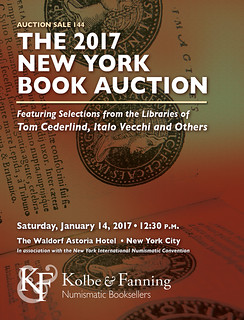 Kolbe & Fanning will be holding our 2017 New York Book Auction on Saturday, January 14 in the 18th Floor Norse Suite at the Waldorf-Astoria Hotel in conjunction with the New York
International Numismatic Convention. The sale features 400 lots of numismatic books from around the world, including rare and desirable works from the libraries of Tom Cederlind and Italo Vecchi.
Kolbe & Fanning will be holding our 2017 New York Book Auction on Saturday, January 14 in the 18th Floor Norse Suite at the Waldorf-Astoria Hotel in conjunction with the New York
International Numismatic Convention. The sale features 400 lots of numismatic books from around the world, including rare and desirable works from the libraries of Tom Cederlind and Italo Vecchi.
The online catalogue, with color illustrations of every lot, has been posted to the firm’s online bidding platform at auction.numislit.com. Printed catalogues have been mailed, and a PDF of the printed catalogue has been posted to the regular Kolbe & Fanning site at numislit.com. Bids may be placed via post, email, fax or phone prior to the sale. Advance absentee bids may also be placed through the online catalogue; live internet bidding will be available during the sale itself through the same platform.
Some sale highlights include:
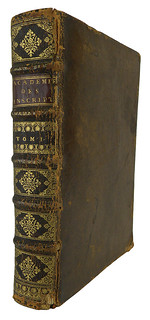
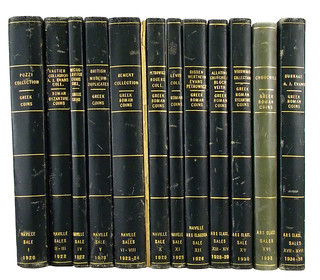
Lots 1 and 6
Lot 1: the 1717 history of the Académie Royale des Inscriptions et Belles-Lettres, with substantial numismatic content
Lot 6: a complete set of Naville/Ars Classica sales, including the very rare Sale 9 on Swiss coins
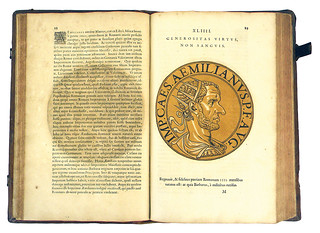
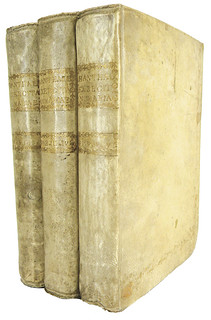
Lots 75 and 86
Lot 75: the magnificent 1645 Icones volume of Goltzius featuring superb oversize chiaroscuro illustrations of Roman coins
Lot 86: a rare set of Hanthaler’s Exercitationes Faciles de Numis Veterum pro Tyronibus
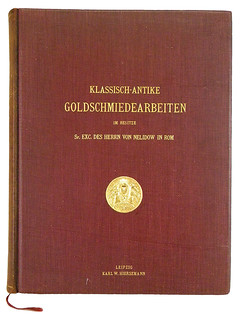
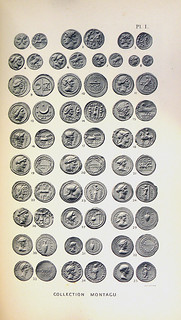
Lots 156 and 173
Lot 156: Ludwig Pollak’s gorgeous catalogue of the Nelidow collection of ancient gold objets d’art
Lot 173: the 1896 Montagu sale of Roman & Byzantine coins, with exceptional plates
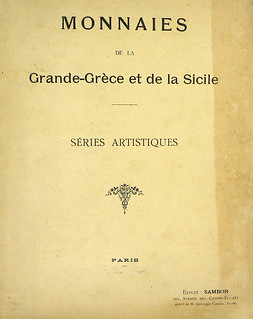
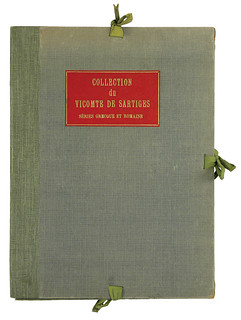
Lots 183 and 192
Lot 183: Sambon & Canessa’s 1927 catalogue of the Duke of Cajaniello collection
Lot 192: a very rare complete set of Sartiges collection plates, with the supplement
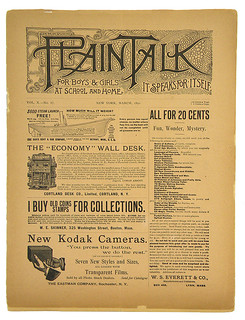
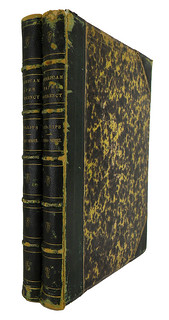
Lots 331 and 378
Lot 331: eight 1891-dated issues of the rare publication Plain Talk, the ANA’s semi-official publication of the time
Lot 378: a large-paper set of Phillips on early American paper money.
The sale features a remarkable number of interesting, often rarely seen, volumes on various aspects of numismatics, and bidders are encouraged to consult the printed or PDF catalogues for full information on each lot (the online catalogue is truncated). More information on the sale will be included in future announcements.
Kolbe & Fanning Numismatic Booksellers LLC is a licensed auction firm in the State of Ohio and is conducting the sale in conjunction with Marissa Russell, auctioneer. For more information, please see the Kolbe & Fanning website at numislit.com or email David Fanning at df@numislit.com. We look forward to your participation.
To read the earlier E-Sylum articles, see:
KOLBE & FANNING’S 2017 NEW YORK BOOK AUCTION (www.coinbooks.org/esylum_v19n49a03.html)
KOLBE & FANNING OFFER THIAN CONFEDERATE CURRENCY ALBUM (www.coinbooks.org/esylum_v19n50a02.html)
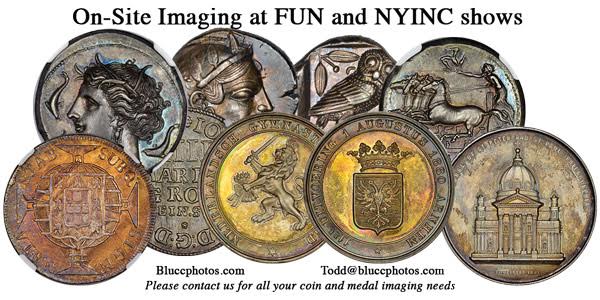
BOOK PLANNED ON VIENNA PHILHARMONIC COIN
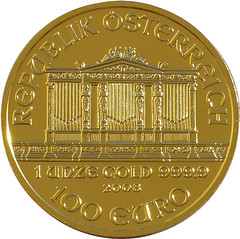
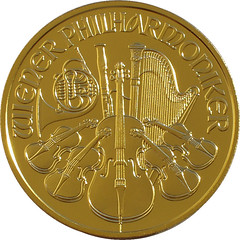
en.wikipedia.org/wiki/Vienna_Philharmonic_(coin)
When you are reading this newsletter, I am no longer sitting at my desk but heading for Vienna. No, this isn’t because I like the Viennese Christmas markets better than the one at Basel (what by the way I do). It’s all about a book I plan to write. It will cover the Vienna Philharmonic bullion coin. I can see in my mind’s eye some very reputable colleagues giving a sniff. A bullion coin? How boring! There’s nothing to write about it!
But did you know that the Vienna Philharmonic was only made possible due to the fact that the Austrian National Bank bought the Austrian coin privilege together with the Vienna Mint from the Government? Did you know that the Vienna Philharmonic was a formidable tool to reduce the enormous percentage of cash sleeping in form of Austrian commemorative coins in collections? Did you know that it was the Viennese Philharmonic which allowed the Austrian National Bank to liquidate a large part of their gold reserves without affecting the international gold price?
The Vienna Philharmonic is probably one of the very few coins that really made monetary history. He bears witness to the fact that true discoveries are not only made in the field of ancient and medieval coins. Contemporary numismatics is full of good and interesting stories that normally nobody bothers to tell.
Yours
Ursula Kampmann
To read the complete Coinsweekly newsletter see:
http://www.newsletter-webversion.de/?c=0-sqeh-87w50o-199e
For a free subscription to CoinsWeekly, see:
http://www.coinsweekly.com/en/Subscribe-to-CoinsWeekly-Newsletter/37
To read the earlier E-Sylum articles, see:
ONE BIG COIN: THE PHILHARMONIC (www.coinbooks.org/esylum_v08n06a27.html)
HOW GOLD COINS ARE MADE (www.coinbooks.org/esylum_v19n09a33.html)
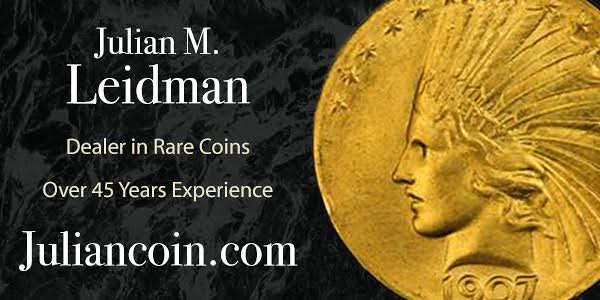
NEWMAN PORTAL ADDS CONNECTICUT MINT ACCOUNT BOOKS
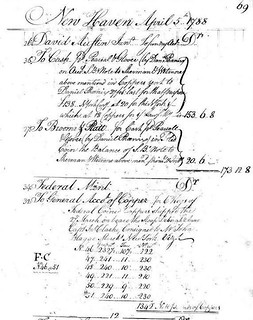 It is rare in American colonial numismatics for original mint documents to survive the centuries, and when they are found it provides tremendous excitement and insight to the hobby and
research community. It is even more rare for two independent researchers, nearly a decade apart, to independently discover the same rare mint documents and bring them to light.
It is rare in American colonial numismatics for original mint documents to survive the centuries, and when they are found it provides tremendous excitement and insight to the hobby and
research community. It is even more rare for two independent researchers, nearly a decade apart, to independently discover the same rare mint documents and bring them to light.
Jay Knipe and Randy Clark, both one-time natives of the New Haven, Connecticut area, separately discovered two Connecticut Copper Mint Account books located in the New Haven Museum. One is dated 1787-1790, from the consortium of Leavenworth-Baldwin-Leavenworth, and the other dated 1788 from the Platt-Broome-Jarvis consortium.
Grayscale images of the mint account books have been posted on the Newman Numismatic Portal, scanned from photocopies acquired by Randy Clark in 2008 from the New Haven Museum. Color images of the mint account books, taken recently by Knipe directly from the original documents, may soon be available on the Newman Numismatic Portal, pending permission from the New Haven Museum.
A transcription of the grayscale copies was made by Clark in 2008 and an independent team is now working with Knipe on a similar transcription from the new color images. The two teams hope to compare the results, and arrive at a single common transcription for publication.
Project Coordinator Len Augsburger adds:
The Newman Portal acknowledges the New Haven Museum for granting permission to post the grayscale images, and Randy Clark for contributing them to the Portal.
Link to New Haven Museum documents on the Newman Portal:
https://nnp.wustl.edu/library/archivedetail/515916
The Colonial Newsletter Editor Chris McDowell writes:
A full and complete typed transcript of the 1788 Connecticut/Federal Mint accounting book will be published in the next issue of The Colonial Newsletter. A full and complete typed transcript of the 1787 Leavenworth Day Journal, which includes the records of the Connecticut Mint from February 1787 to early 1788 will be published in The Colonial Newsletter later this year.
MINT COLLECTION ACQUISITIONS RESEARCH
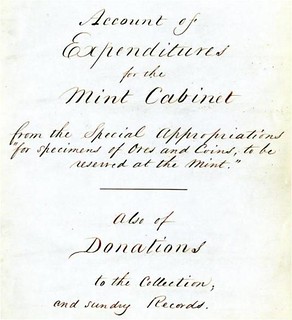 I was wondering if any of the E-sylumites have ever tried to figure out where the Mint Collection acquired some of its pieces.
I was wondering if any of the E-sylumites have ever tried to figure out where the Mint Collection acquired some of its pieces.
The attached spreadsheet is an extract from the Mint Account book of the U.S. coins originally done by John Dannreuther.
This book starts in 1858 and is now on the Newman portal at the link below.
https://archive.org/details/
MintAccountsBook18561903
As you can see, I have traced some Mint collection purchases to such sales as Bushnell, Cottier and Cleaney but am having trouble with some of the others.
Any help other E-sylumites can provide to fill in the rest would be greatly appreciated and would be happily shared with all.

The Newman Numismatic Portal link is:
https://nnp.wustl.edu/library/archivedetail/513266
To read the earlier E-Sylum article, see:
NEWMAN PORTAL ADDS MINT CABINET ACCESSION BOOK, 1856-1903 (www.coinbooks.org/esylum_v18n52a03.html)
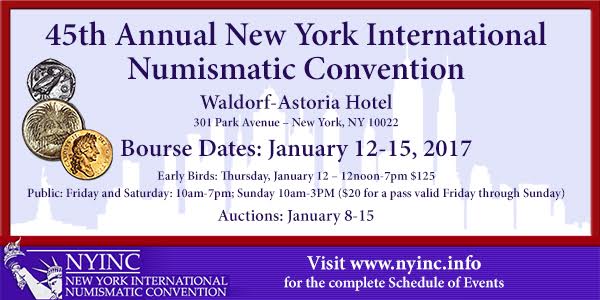
M. H. BOLENDER AUCTION SALE CATALOGS
I spent a few enjoyable hours last weekend looking through the Newman Numismatic Portal (NNP). I’ve collected M. H. Bolender auction sale catalogs for a decade or two. The NNP now has a long run of these sale catalogs scanned and online, from 1925 to 1960. The 1925 through early 1928 catalogs were printed in a small size format. The September 1928 catalogs and later were approximately the size of our John Reich Journal. At one point in the 1950s Bolender went back to the small format for these catalogs.
Milferd H. Bolender was a dealer and was originally from Freeport, Illinois. He eventually retired to San Marino, California. Bolender was the author of THE UNITED STATES EARLY SILVER DOLLARS FROM 1794 TO 1803; the first edition of this book was published in 1950. This book essentially updated and replaced the Haseltine Type Table sale (1881) as the primary reference for the early dollars.
As I paged through a fair number of the catalogs, I noted that the early U.S. silver dollars 1794 to 1804 were cataloged using Haseltine numbers from 1925 to 1949 or so, then Bolender numbers from 1950 on. It was fun to see half dollars attributed by both Haseltine and later Beistle numbers, and half dimes with Newlin numbers! As might be expected, early quarters and dimes seemed to appear much less frequently in these sales than the half dimes, half dollars, and early dollars 1794-1803.
Bolender’s sales offered a wide assortment of lots, including U.S., foreign, and ancient coins, currency, Colonials, tokens, medals, and Numismatic Literature.
What amazed me the most was that by 1959 Bolender stated he had over 16,000 names and addresses on his mailing list. By 1960 this number was over 20,000! I can only imagine the efforts and cost that went into printing the catalogs, typing the name and address, inserting the catalogs into envelopes, and mailing all of these in the 1955-1965 time frame!
I have a number of Bolender sale catalogs in the original mailing envelopes that I purchased years ago from Numismatic Literature dealer Charles Davis. I’ve attached a photo of the mailing envelope for the June 14, 1944 Bolender 159th Sale. Note that the address appears to be typed on the envelope, and Bolender had a postage permit coincidentally No. 159). I especially got a kick out of the “DATED SALE CATALOG / USELESS IF DELAYED” above the return address on the top left of the envelope!
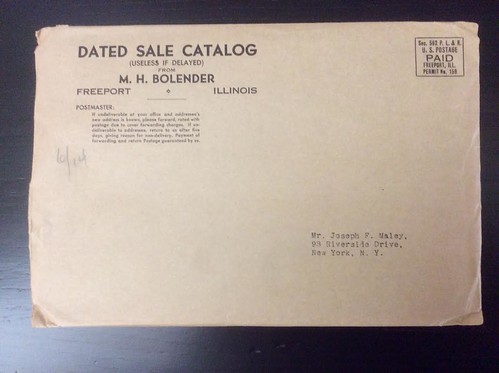
W. David Perkins
Centennial, CO
www.davidperkinsrarecoins.com
To read the complete JR Newsletter issue, see:
JR Newsletter: 18 December 2016 (324)
(http://us11.campaign-archive2.com/?u=74a0e3c37d154d935bdeb2daf&id=4bb9e499c4&e=9b1d009ea9)
THE CHASE MANHATTAN BANK MONEY MUSEUM
Ken Berger writes:
The last E-Sylum mentioned some of the various now-defunct bank money museums. Attached are the cover pages of three publications from the former Chase Manhattan Bank Museum of Moneys of the World which I have in my library.
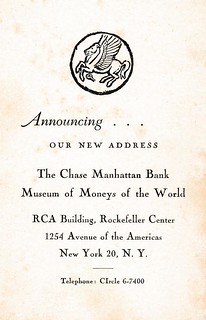
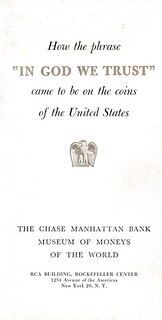
Left: Announcing Our New Address - RCA Building
Right: Pamphlet: How the phrase "In God We trust"
came to be on the coins of the United States
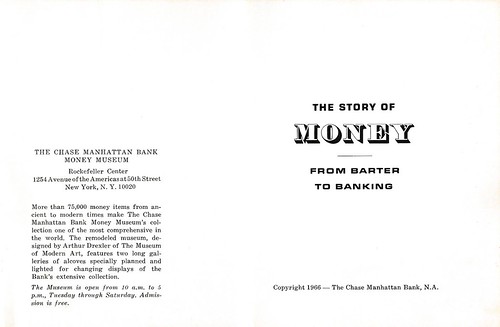
Pamphlet: The Story of Money from Barter to Banking
To read the earlier E-Sylum article, see:
NEWMAN PORTAL RELEASES NEWMAN MUSEUM VIDEOS (www.coinbooks.org/esylum_v19n50a05.html)
MORE ON THE MYSTERY CATALOG OF ENGLISH COINS
Ron Haller-Williams writes:
Note the unusual (and probably archaic) spelling CUNOBILIN. Also note the long "s" in "sitting", "something", "cross", etc. but NOT "Silver" (capital) or "reverse".
Unless I've misread it, there are TWO columns for weight in the Anglo-Saxon (Kent) coins:
* col.1 "No."
* col.2 "Metal"
* col.3 "Grains"
* (col.4 is the description)
* col.5 "Weight" "Grs" though I am unsure of the entries in column 5: "17 1/4" and "16 1/4" ?
I guess that this is a descriptive catalogue of a (private or museum) collection.
Mind you, I would love to see the reverse of British #1: "A Minter sitting at work"; if accurately described (rather than being a seated Nike/Victory), this must be one of the earliest coins to refer to its manufacture! I'd also like to see the dragon (Kent #2), which again must be one of the earliest such.
One does wonder whether the "rude figures" relate to the level of detail/skill with which they are depicted, or to any gestures which they might appear to be making ...
Ron Haller-Williams adds:
We don't necessarily want it to be of a rare coin, though. A rare descriptive term will do. I wonder how often one sees in this sort of context (ancient coins) the descriptions which I picked up on:
* "A Dragon";
* "A Minter sitting at work".
I haven't seen Harry's works, but a machine-searchable version might be of great help!
To read the earlier E-Sylum article, see:
HELP IDENTIFY THIS CATALOG OF ENGLISH COINS (www.coinbooks.org/esylum_v19n50a06.html)
NOTES FROM E-SYLUM READERS: DECEMBER 18, 2016
Two Dollar Bill Documentary on Amazon Video
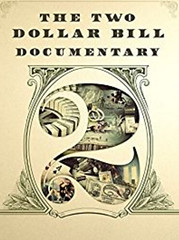 Regarding his documentary on the two dollar bill, filmmaker John Bennardo writes:
Regarding his documentary on the two dollar bill, filmmaker John Bennardo writes:
I thought it might be of further interest to you and your readers to know that the film is now, finally, available on Amazon Video, where it can be rented for $2.99 and watched online on a computer or tablet.
For more information, or to purchase, see:
http://amzn.to/2gpRKum
To read the earlier E-Sylum articles, see:
THE TWO DOLLAR BILL DOCUMENTARY (www.coinbooks.org/esylum_v19n36a19.html)
SCREENING THE TWO DOLLAR BILL DOCUMENTARY (www.coinbooks.org/esylum_v19n37a11.html)
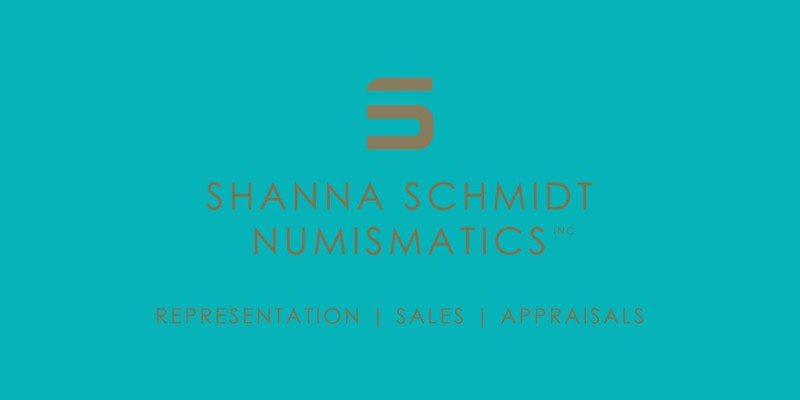
TO INSCRIBE OR NOT TO INSCRIBE
Lee Barrett writes:
I have been following the threads regarding signed/personalized books with a touch of disappointment. I am greatly disappointed to learn of this apparent trend or preference that only well-known or accomplished numismatists are worthy of a personalized book. Over the years I have drifted in and out of numismatics, normally drifting out as a result of the us/them mentality that has been very pervasive in some corners of the hobby. Finding acceptance in our hobby can often be daunting. Just a few short weeks ago, the hobby headlines were nervously wringing collective hands over the aging numismatic demographic. Commentators were asking, "Where are the collectors going?" When faced with a numismatic elitism that surfaces in sentiments such as this, it should be no surprise that many drift other directions.
As my own desire in medals continues to grow, the purchases for my numismatic library have taken a new direction. Last summer I even had the great honor of dipping my toe into the water with a presentation at Anaheim. Yet I am not widely known in numismatics, and I am not considered an established numismatist. Does this mean than I am less worthy of establishing a relationship with an author? Do I not dare seek entry into the club via the affirmation of a fellow writer? Fortunately for me, the vast majority of medal collectors/researchers/writers I have encountered have been very kind, collaborative, even selfless.
It seems this is not universal across the hobby. Where are the collectors going, indeed?
I know of no such trend or preference and had to go back and read the earlier thread started by Ken Berger who wrote, "Personally, I like books signed by the author but not books which also include a written dedication to a specific individual." That was the first I'd heard of a preference either way on a written dedication. My response was, "I generally like personalized inscriptions, and if the recipient is a known numismatist, all the better." So far, no snubs made or intended.
Gary's response last week included this: "I am tempted to avoid adding a personal note if the buyer is not known in the numismatic field. I can see the reasoning on both your part and Editor Wayne’s who favors books which have been signed to a noteworthy numismatist."
This is what Lee is referring to. By "all the better" I intended a mild positive for those who are known in the field, not anything negative against those less so. Gary used the word "favors" to describe my view. Here are his thoughts and some additional information about how author signatures and dedications and seen in the larger book world. Thanks! -Editor
I don’t think it is about noted numismatists being worthy of a personalized book, but the personalized book being more valuable because of the connection of the author and the friend he or she salutes.
I did some research on signing books universally – not numismatically. Here are some of what appear to be fundamentals of signed books, separate from limited editions, which we can address also.
The book field has some categories of signed books: Not all signatures are created equal. In fact, signatures or autographs and the inscriptions accompanying them fall into different categories.
“Signed” means the book is signed by its author or editor. It has no personalization. Generally speaking, signed books are desired by collectors, and a signature can enhance the value of the book. I presume this is the case in numismatics where ‘rare’ and ‘scarce’ are a part of the hobby?
A dated signature is considered worthwhile, especially if the date is close to the date of the book’s publication. Some dealers will point out that a book is “signed in the year of publication.”)
It appears that just a signature in a book is potentially more valuable than one that also says “Best wishes to _______________.
An “association copy” is a book signed by the author, is addressed to a specific individual connected to him or her. This is often another writer, a well-known person, or someone else connected to the author. The term can also refer to a book owned by famous person or someone involved with the author. The closer the connection, the more it can enhance the book’s value.
A “dedication copy” is one which the author has signed for the person to whom the book is dedicated. This is clearly a rare version of an autographed book. Signatures naturally tend to be more common than inscriptions and/or association copies.
An “inscribed” book is personalized — addressed to a specific person. If the person isn’t closely associated with the author, the inscription usually does not add much to a book’s value. Contemporary authors often do book signings when they go on tour, thereby increasing the number of signed books in existance and decreasing the value of such signed copies.
A book signed as a gift by someone other than the author: Gift inscriptions detract from a collectible book’s value. This means that if you are giving a potentially valuable book as a gift, it is best to just slip in a card with your gift notation rather than to write on the book.
An autopen signature is often seen with presidential materials. An autopen is a machine used for the automatic signing of a signature. This isn’t really a signature and doesn’t add anything to the value of the book.
An author’s signature may or may not add to the value of a book
If a book is signed by the author, it may be worth more than an unsigned copy. The difference could be large, moderate, or negligible, depending upon the book. There’s no rule. If the author is
popular, but his or her signatures are scarce, there will be a greater demand. Collectors note if the author is alive or dead. A dead writer means no more books will be getting signed. Value is also
based on whether the author signed a lot of books or just a few, and the desirability of the book itself.
Books signed by heavily-collected authors are much-desired. For example, every one of the thousands of collectors of Harry Potter literature would love to have a signed book by J. K. Rowling in their collection. I don’t know if she is a prolific signer of her books.
For modern novels with authors still living, a signature will add somewhat to the price – perhaps 10% to 25% percent is estimated. If the signature is very scarce, it may be worth more. The amount varies depending upon the book and author and how easy that signed book is to find. However, an unknown writer’s signature, and his unknown book, are likely not objects of desire for book collectors.
Considerations of limited edition books:
A limited edition book is one where the number of copies in the print run has been strictly defined prior to its issue, and that number is substantially less than a standard print run, and then no
further print runs are issued after the first printing has sold out. A limited edition book does not automatically become rare, collectible or valuable. The number of copies printed must be evaluated
as supply can outstrip demand, holding down future value.
Limited editions are designed to be collectible. Owners are far less likely to allow damage or thumbing of their collectors’ items so a larger percentage will be in top condition after many years.
A rare book with less than 26 copies can be a lettered, rather than numbered edition. Each book has a different letter of the alphabet. Some lettered editions are limited to 52 copies and individualized with upper and lower case letters.
Limited editions can also be stand alone releases such as a novella or a short story where the limited edition is the only time the author plans to release that work for purchase. Alternately a limited edition may be published along with with a standard print run. The limited edition would contain additional features such as better quality paper, extra illustrations, author signatures, different cover art, a slip case, or some other type of benefit or feature that is not normally included in a book from that author or publisher.
To read the earlier E-Sylum articles, see:
NOTES FROM E-SYLUM READERS: DECEMBER 2, 2016 : On Serially Numbered Numismatic Books (www.coinbooks.org/esylum_v19n49a11.html)
NOTES FROM E-SYLUM READERS: DECEMBER 11, 2016 : More on Signing Books (www.coinbooks.org/esylum_v19n50a08.html)
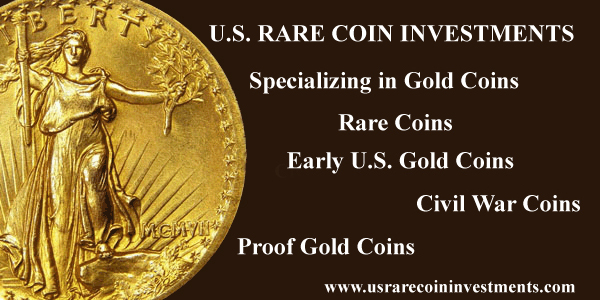
THE 1950 AMERICAN LEGION SCHOOL AWARD MEDAL
1950: The American Legion School Award medal was completely revamped. A new design front and back, One uniform size. This design was applicable for award to either boys or girls. Again in bronze, 2½-inches across from the Medallic Art Company.
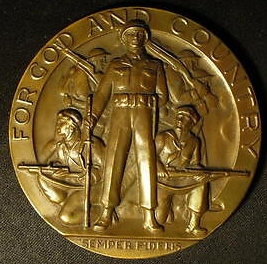
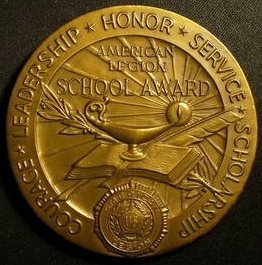
The legend, motto, name and award attributes are the same as the male award from 1922 but the central devices are all new. The military motif on the obverse is now WWII with a soldier, sailor and airman in the foreground with troops in full pack going by behind. At parade rest, on alert and on the march, the medal is all about military preparedness. The reverse has lost the eagle and moved to a central composition of a radiant lamp of knowledge sitting atop an open book above a crossed olive branch and feather pen. A very well thought out design for this award. The sculptor has not been identified but he was certainly talented and skillful. The sculptor Paul Fjelde (1892-1984) has been suggested but further research is required.
Web site visitor Edward Stevens writes:
I bought one of these medals at a garage sale and while investigating found your article. I also found a Smithsonian article saying that the sculptor's wife gave one to the Luce collection and his name was Joseph Renier.
OBJECT
The American Legion School Award began as a yearly prize given to males graduating from the eighth grade. On the reverse of Joseph Renier’s medal, the lamp of wisdom rests upon an open book. The
five-pointed star below represents the qualities listed around the perimeter of the image. This star also symbolizes the five branches of the military that appear on the obverse: here, a sailor, an
aviator and three soldiers evoke not only the organization sponsoring the award, but also the ideal career of the student who receives it.
ARTIST
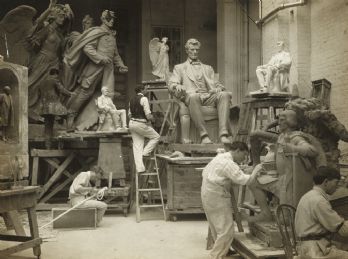 Joseph E. Renier
Joseph E. Renier
(born Union Hill, NJ 1887 -- died New York City 1966)
Joseph Renier grew up in New Jersey and studied at the Art Students League in New York. He attended art schools in Paris and Brussels, and in 1915 won the Prix de Rome to study at the American Academy. He served with the American Red Cross in Italy during World War I and in 1921 finally returned to America. He created many architectural sculptures, reliefs, and medals, which included designs for the Veterans of Foreign Wars, the Civil War Centennial, and the American Heart Association. In 1959, Renier was awarded the gold medal for sculpture from the American Artists Professional League.
Image Credits: Photographed by J. H. Hare. Image is courtesy of the Adolph A. Weinman papers, 1893-1960 in the Archives of American Art, Smithsonian Institution.
To read the complete article, see:
Sculpture: Medals: American Legion School Award Medal
(http://americanart.si.edu/luce/object.cfm?key=338&artistmedia=0&subkey=171687)
To read the earlier E-Sylum article, see:
THE AMERICAN LEGION SCHOOL AWARDS (www.coinbooks.org/esylum_v17n06a26.html)
JOSEPH EMILE RENIER (1887-1966)
Medallic Art Company (MACo) hired Joseph E. Renier to make the models for the Morris medal. Renier was born in Union City, NJ in 1887 and he received his early art education at the Art Students League in New York.
He later studied under M. Victor Rousseau in Brussels and at the American Academy in Rome. In World War I he served with the American Red Cross and he received a commendation from the Italian Government for his work at the wartime settlement at Monteporzio in the Sabine Hills near Rome.
Joseph Renier is most well known for his heroic-size group Speed at the 1939 World's Fair in NYC. For 14 years Renier was an Associate Professor of Life Drawing at the Yale Fine Arts School. He also taught architectural drawing at New York University (NYU) for several years. He designed the Civil War Centennial Medal in 1961 and the Mark Hopkins Medal for the NYU Hall of Fame for Great Americans series. He modeled medals for the American Heart Association and the VFW. Renier. himself, was the recipient of many awards, The Samuel F. B. Morse Medal, the Elizabeth N. Watrous Gold Medal and the Daniel Chester French Medal of the National Academy of Design. Renier was a sculptural traditionalist and was on the Medallic Art Company short list of favored medallists.
In 1950 at the behest of MACo Renier produced these designs for a new American Legion School Award.
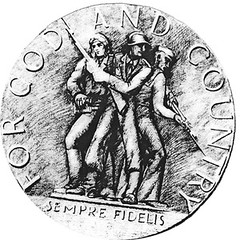
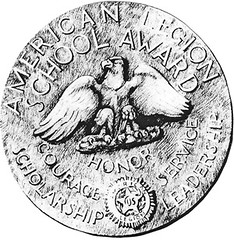
These sketches did not find favor with Carlos Morris. He was the Director of American Legion Emblem Sales and in 1950 he submitted the design of the new School Award for US Patent protection and Morris listed himself as the inventor on the patent application. Clyde Trees of Medallic Art returned them to Renier on September 8, 1950 with this note: "They have decided to handle the design for their pieces through a local artist and it will be purely a commercial item. They will not use sculptured designs such as we have prepared." On October 11, Renier got the purchase order for the new School Award. "Please proceed with the obverse and reverse models for the American legion as per their design. Make these 10" in diameter. The relief to be the same as the Old American Legion models made by R. Tait McKenzie. The obverse: as we discussed it, the border where the inscription is around is flat and from there, there is a slight convex curvature, not too great, and that will give the appearance of the figures of the soldiers to be of higher relief than they would be on a flat surface. You are to follow the details on the drawing texturely (sic) and make no change whatever from their conception. This holds good for both obverse and reverse." Joseph Renier rendered his invoice to Medallic Art on October 27, 1950: $300 for the American Legion medal as per drawing submitted.
It is too bad the 'local artist' was not identified in the note from Clyde Trees to Joseph Renier. There is still a question whether Carlos Morris was the actual designer or an Indianapolis artist drew up the design to Morris' specifications. In any case this design is credited to Carlos Morris in this article.
In 1951 the new School Award medal was struck along with the accompanying pin of the reverse or a stand-alone hanging badge. Joseph Renier did an excellent job of recreating the Morris design in bas-relief. This medal in various iterations had a 23 year run.
Harry Waterson adds:
This article is the latest of three I have written so far about the ALSA. There was a second article in JOMSA, the Journal of the Orders and Medals Society of America entitled “The American Legion School Award, An Educational Progression” in the Nov.-Dec. 2014 issue.
THE BOOK BAZARRE
VOCABULARY TERM: DIE VAULT

Moisture is the enemy in a die vault, it must be kept dry and moderate temperature. If not rust will occur on the face of a die. The dies are arranged on sturdy shelves. In this die vault the die numbers are painted on the side of the die. Photo: Medallic Art Company.
Die Vault. A vault for the special use of die storage, usually on well supported shelving and in controlled atmosphere to prevent rusting. Dies are stored in pairs (obverse and reverse) and is best to be stored with a struck piece between them. Usually the dies are accompanied by any special tooling – collars, blanking or piercing tools, roller dies, jigs, masks, nests and such (if these are not stored in their own special tool bins). Die vaults should be dehumidified thus contain some kind of mechanism to remove moisture from the air. See DIE RETENTION, RUSTED DIES.
WILLIAM ENGLISH MICKLE (1846-1920)
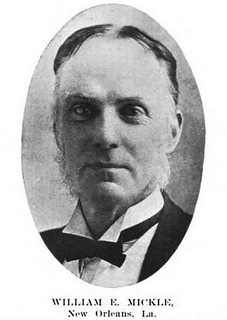 For the Civil War numismatic specialist on Confederate States of America memorabilia and C. S. A. money and stamps, here is a biographical sketch of one of the most important specialists
and dealers -- Major General William English Mickle. Mickle is a contemporary of the thirteen-year younger Luther Brown Tuthill (1859-1930) who also specialized in Confederate Paper Money as a dealer
in South Creek, North Carolina (q.v.).
For the Civil War numismatic specialist on Confederate States of America memorabilia and C. S. A. money and stamps, here is a biographical sketch of one of the most important specialists
and dealers -- Major General William English Mickle. Mickle is a contemporary of the thirteen-year younger Luther Brown Tuthill (1859-1930) who also specialized in Confederate Paper Money as a dealer
in South Creek, North Carolina (q.v.).
William English Mickle (1846-1920), was born the son of Joseph Thomas Mickle (-1898) and Nancy C. Gandy Mickle, on October 31, 1846 in Columbia, Richland County, South Carolina. He is the grandson of Major Joseph and Martha Belton Mickle of Kershaw County, South Carolina. His father was a very successful merchant and banker who moved to Mobile, Alabama in 1852. His father organized the "Merchants Guard" during the Civil War.
He was educated at Summerville Institute, Noxubee County, Mississippi. On August 20, 1864, he went from school directly in the Confederate Army in the Mobile Cadets, Company A , 3rd Alabama Infantry, Army of Northern Virginia (of Battle's Brigade, near Winchester, Virginia). His urgency to enlist was prompted by the death of his brother Joseph English Mickle who was killed in battle at Warrenton Junction, October 14, 1863. He was severely wounded twice at the Battle of Cedar Creek, October 19, 1864. He was hit by shrapnel and as he was being carried off the field was shot in the right ankle.
He only experienced two months of active duty in the field during the Civil War. He was furloughed home only to return to duty on crutches the following February 1865. The Confederate medical examiner retired him for nine months, during which time the War had ended. After the War he worked as a teacher in the school system at Barton Academy in Mobile, Alabama. He became the school principal of the Boys' Senior Grammar School. He married Ellie Squire Woodhull (born in Branford, Connecticut), daughter of John F. Woodhull (d. 1894), now of Mobile on October 8, 1867, at Mobile, Alabama.
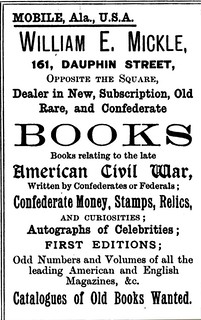 In 1869, he left the field of education entering the book trade at New Orleans, Louisiana, and at Mobile, Alabama. He established one of the most noted Bookstores in the South located on
Dauphin Street, Mobile, Alabama.
In 1869, he left the field of education entering the book trade at New Orleans, Louisiana, and at Mobile, Alabama. He established one of the most noted Bookstores in the South located on
Dauphin Street, Mobile, Alabama.
On June 10, 1889, he was a founding and charter member of the Raphael Semmes Camp, No. 11, United Confederate Veterans, of Mobile, Alabama, serving as the adjutant lifelong. On January 19, 1903, he was made Major General by General J. B. Gordon, Commander-in-Chief. He also served as "Pension Examiner" for the State of Alabama for several years.
He is the author of, Well Known Confederate Veterans and Their War Records, Arranged Alphabetically (1907, and 1915), a significant work vital to the study of Confederate soldiers.
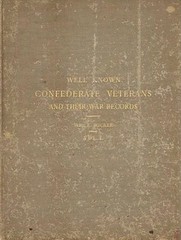 He died on February 18, 1920 at his home 405 1/2 Church Street, Mobile, Alabama. Funeral services were held at the Government Street Presbyterian Church. He is buried at Magnolia Cemetery.
He was survived by his wife, three daughters Louie, May, and Josephine, and his son, William English Jr. A collection of 430 of Mickle's papers are in the Perkins Library, Duke University,
Durham, North Carolina. Rare book collectors look for the "Mickle, Mobile, Ala" stamp in old books that were sold from his bookstore. The 1907 edition of his book Well Known Confederate
Veterans typically sells for $400.
He died on February 18, 1920 at his home 405 1/2 Church Street, Mobile, Alabama. Funeral services were held at the Government Street Presbyterian Church. He is buried at Magnolia Cemetery.
He was survived by his wife, three daughters Louie, May, and Josephine, and his son, William English Jr. A collection of 430 of Mickle's papers are in the Perkins Library, Duke University,
Durham, North Carolina. Rare book collectors look for the "Mickle, Mobile, Ala" stamp in old books that were sold from his bookstore. The 1907 edition of his book Well Known Confederate
Veterans typically sells for $400.
To read the complete article, see:
MICKLE, MAJOR GENERAL WILLIAM ENGLISH
(https://sites.google.com/a/numismaticmall.com/www/numismaticmall-com/mickel-william-e)

WALDO NEWCOMER BANK STOCK CERTIFICATE
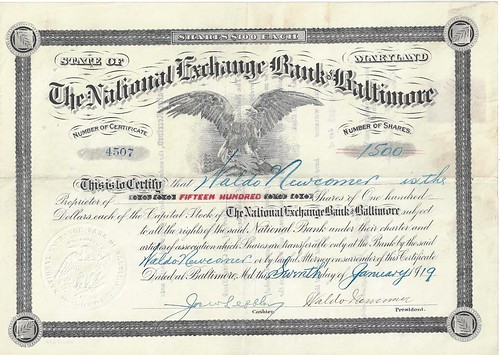
Russ Sears writes:
 I have seen the name of Baltimore collector Waldo Newcomer a couple times in recent weeks and thought your readers might like to see the attached. It is a 1919 stock certificate for The
National Exchange Bank of Baltimore for 1500 shares made out to and signed by the president, Waldo Newcomer. The back includes his signing over the ownership of the stock and his signature.
I have seen the name of Baltimore collector Waldo Newcomer a couple times in recent weeks and thought your readers might like to see the attached. It is a 1919 stock certificate for The
National Exchange Bank of Baltimore for 1500 shares made out to and signed by the president, Waldo Newcomer. The back includes his signing over the ownership of the stock and his signature.
Another interesting piece of history.
AUDIO: Q&A WITH LEROY VAN ALLEN
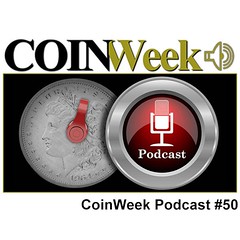 CM: So, you said earlier in our conversation that for a time that people could walk up to their bank and get Morgan dollars at face value. Collectors that came around the hobby long
after that probably really relate to that story. It boggles the mind. But going back to the early 1960s, about how many Morgan dollars or dollar coins do you think your typical local bank would have
in the cash drawer and what condition would they typically be in?
CM: So, you said earlier in our conversation that for a time that people could walk up to their bank and get Morgan dollars at face value. Collectors that came around the hobby long
after that probably really relate to that story. It boggles the mind. But going back to the early 1960s, about how many Morgan dollars or dollar coins do you think your typical local bank would have
in the cash drawer and what condition would they typically be in?
LV: Well, George Mallis lived in Massachusetts, but he was an architect and he had some jobs down in the Washington, D.C. area. So he would go to the Treasury Department and he would get a bag of a 1,000 and lug it home. This was in the early 1960s, ’61, ’62, and ’63. And then study them. Meanwhile, I lived in Baltimore, Maryland.
I would go to a reserve bank in Baltimore and also to the Treasury Department in Washington, D.C., since I worked down in Washington, D.C. And I’d get a bag of a thousand and take it home and look at it. I’d always be disappointed when it was just one date, like a ’98-O, or ’04-Os... I liked the mixed date bags. Sometimes they were quite circulated. Other times, they were a mixture of circulated and uncirculated.
And then I would go to local banks in Baltimore and also in D.C., and there you could get bags from them for a while. Then they started rationing. You could only get a couple rolls, or something like that. Then it was just a roll. And finally, it was just a single coin as they ran out of them. So it was quite an experience and you’d get all of these coins just for a dollar, big coins that were minted way back in the 1880s and 1870s, whereas all the minor coins, you couldn’t go to the bank and get coins that old. So for me, that was the thrill of it.
CM: And you could probably get some well-worn Seated dollars once in a while in circulation?
LV: Yeah, once in a while, in those bags... and circulated mainly, there would show up some Seated Liberty dollars. I got a number of those also. But they were pretty few and far between. They weren’t like the Morgan dollars, where you could get a lot of uncirculated ones. You could get all dates, except for the 1889-CC, just going through bags and getting them for a dollar each. And so did my co-author George Mallis.
But it was really crazy when they started to run out and the dealers would flock down to Washington, D.C. and stand in line to get those bags. I did some of that also.
To read the complete article or access the podcast, see:
CoinWeek Podcast #50: Talking Morgan Dollars with Leroy Van Allen
(www.coinweek.com/coinweek-podcast/coinweek-podcast-50-talking-morgan-dollars-leroy-van-allen/)
To read the earlier E-Sylum article, see:
VAN ALLEN'S 1964 MORGAN DOLLAR ANALYSIS (www.coinbooks.org/esylum_v19n50a14.html)
THE BOOK BAZARRE
THOSE “SOFT HUNDRED DOLLAR BILLS”
Greg Ruby's blog The Fourth Garrideb - Numismatics of Sherlock Holmes republished an interesting article from a 1910 issue of Banker's Magazine which was itself a reprint from the New York Sun. And here we are republishing it yet again. Thanks to Greg for adding the nice illustration.
Lots of hidden gems like this await researchers and are just a click away with the Newman Numismatic Portal. See the link below to read the original, or perform a search on your own favorite topics. -Editor
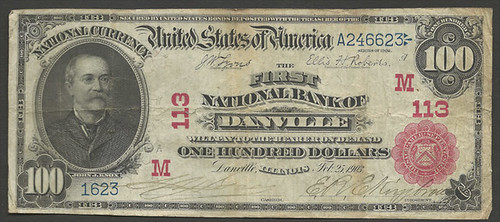
A “soft” $100 note from the First National Bank of Danville, Illinois
“The request for an ‘old soft hundred dollar bill’ has become so frequent of late,” said the ladies teller in an uptown bank, “that I made so bold as to ask a friendly depositor what this feminine craze for shabby hundred dollar bills stood for.
“’All your hundred dollar bill ladies have autos, I suppose?’ she said. I admitted that most of them had.
“’Most of them have country places within easy motoring distance?’ was her next question. I thought a minute and said that many of them were semi-suburbanites.
“She then went on to say that if I was any kind of a Sherlock Holmes I’d be able to put these facts together and see that suburban living often necessitate rapid motoring; that this meant arrest and that bail was a good thing to have on hand. An extra hundred dollar bill, closely wadded and pinned under a cushion of the machine was fairly safe from theft and often saved the situation. A new bill is too crisp for pinning and is apt to rustle when touched. The old bill’s just the thing for tucking away in a card case or vanity bag or pinning in some pocket of the machine. ‘Quite safe, but effective,’ was the way she summed up the bailing virtues of the shabby hundred dollar bill.” – New York Sun
To read the Fourth Garrideb article, see:
Those “Soft Hundred Dollar Bills” (1910)
(http://fourthgarrideb.com/2016/11/those-soft-hundred-dollar-bills-1910/)
To read the Banker's Magazine article, see:
The Bankers Magazine [vol. 81] (https://nnp.wustl.edu/library/book/520281?page=998)
MORE ON HIDDEN PROPAGANDA IN CHINESE BANKNOTES
Last week we discussed secret propaganda messages hidden in Chinese banknotes produced during the Japanese occupation during World War II, in an article from the National Numismatic Collection.
Reader Herb Friedman notes that he wrote about the topic in 2004. Here is an excerpt from his Psywarrior web site. -Editor
The history of Chinese propaganda currency is so rich that I wrote about it on two occasions. The first was "Secret Symbols on WWII Occupation notes of China for Coins, June 1973. The second article was "Propaganda Currency of China," International Banknote Society Journal, Volume 23, No. 3, 1984. Readers who want to study the propaganda of China in more depth should obtain these original reference works. For the purposes of this article I will just state that the Chinese printers who prepared the banknotes for the puppet banks under Japanese authority allegedly placed a number of propaganda symbols on the various banknotes that they designed. These may or may not be actual propaganda. Chinese patriots say that they are, others doubt the claims.
In some cases they added letters to the scrollwork on the banknotes. For instance, on the Central Reserve Bank of China 50 cents note of 1940 they dispersed the English letters "C G W R S." The letters allegedly represent "Central Government Will Return Soon." The Central Reserve Bank was chartered 19 December 1940 under the authority of Wang Ching-Wei, chief of the pro-Japanese collaborationist government.
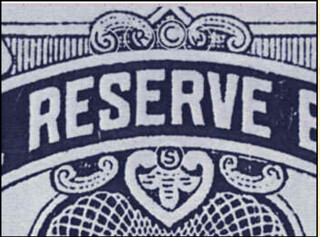 The English letters "CGWRS" are dispersed within the scrollwork above and below the word "Reserve" on the back. In the upper scrollwork four letters are in a line from
left to right in the following order: "G," "R," "C," and "W." The "S" is at upper center in the lower scrollwork. The front of the note contains five
hidden Chinese characters that have a similar meaning, located on the Sun Yat Sen mausoleum and in the trees surrounding the mausoleum. The true meaning of the letters has been questioned, but
"Central Government Will Return Soon" was a popular and well known propaganda slogan, so there is some reason to believe that these symbols were hidden on the banknote for propaganda
purposes. This banknote underwent three printings, with color changes, without the propaganda being detected by the Japanese. The 50 cent banknotes are found in red-brown, orange, and purple.
The English letters "CGWRS" are dispersed within the scrollwork above and below the word "Reserve" on the back. In the upper scrollwork four letters are in a line from
left to right in the following order: "G," "R," "C," and "W." The "S" is at upper center in the lower scrollwork. The front of the note contains five
hidden Chinese characters that have a similar meaning, located on the Sun Yat Sen mausoleum and in the trees surrounding the mausoleum. The true meaning of the letters has been questioned, but
"Central Government Will Return Soon" was a popular and well known propaganda slogan, so there is some reason to believe that these symbols were hidden on the banknote for propaganda
purposes. This banknote underwent three printings, with color changes, without the propaganda being detected by the Japanese. The 50 cent banknotes are found in red-brown, orange, and purple.
The same message is hidden in Chinese characters on the back of the 50 cents note. Chinese banknote collector Yuyuan Gu told me in 2012 that he had also found secret Chinese characters hidden on the back of the Central Reserve Bank Chinese 50 cents banknote. He says they can be arranged as “Central Government Will Return Soon.” I thought this was new information, but when I mentioned this to my friend and advanced collector Frank Prosser, he told me that I had written about these very characters in Coins, June 1973. Frank knows my research better than I do.
To read the complete article, see:
WWII ALLIED PROPAGANDA BANKNOTES : China (www.psywarrior.com/WWIIAlliedBanknotes2.html)
To read the complete article, see:
HIDDEN PROPAGANDA IN WWII-ERA CHINESE BANKNOTES (www.coinbooks.org/esylum_v19n50a31.html)
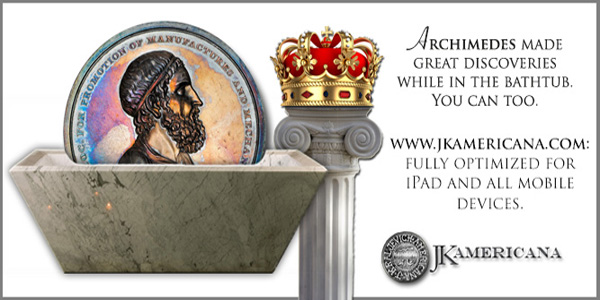
"1600" SMARTPHONE APP TRANSFORMS $1 BILL
Regarding the new "1600" smartphone app by the White House Historical Association, David Sundman writes:
This is a fun free app that starts with a $1 bill. After you have the app installed on your iPhone or iPad you just point it a dollar bill. From there it's transformed before your eyes into the White House, complete with helicopter. My five-year-old grandchild loved it!
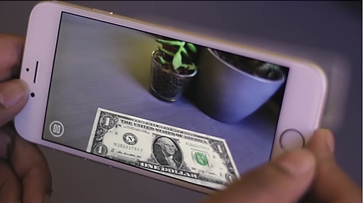
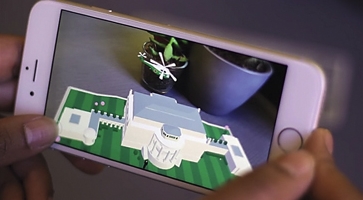
Thanks to the White House press office, the White House Historical Association and Nexus Studios, $1 notes have a new use that is anything but monetary in nature.
A free app for Android and iPhone or iPad called “1600” was announced by Press Secretary Josh Earnest on Dec. 1. It is called a new way for Americans of all ages to learn about the president’s house and what happens there. All you need to do is download the app, tap “Start” and point the camera of your device at the portrait of George Washington. The seals spin and suddenly you see an interactive 3D video, “1600 — a Year at the White House” in an augmented reality pop-up.
You see Marine One arrive, the Easter Egg Roll and a State Arrival Ceremony, all amid changing seasons and people moving in and out.
To read the complete article, see:
‘Entrance fee’ of $1 (and a phone app) gets you a White House tour
(www.coinworld.com/news/paper-money/2016/12/turn-a-1-dollar-note-into-a-tour-of-the-white-house.html)

WAYNE'S NUMISMATIC DIARY: DECEMBER 18, 2016
Kid Time
Last Saturday morning December 10, 2016 I left home midmorning to go to the Annandale (VA) coin show and help run our regular kids program. I'd done some prep work the previous Tuesday when I
visited Wayne Herndon's Wizard Coin Supply office and spent a couple hours organizing materials for the event - auction lots, auction dollars, giveaways, and all sorts of donated coins, medals,
tokens and paper money.
When I arrived my fellow Nummis Nova members had everything well in hand. Nummis Nova is my Northern Virginia numismatic social group. Jon Radel was signing in late arrivals, auction lots and displays were in place, and Tom Kays and Joe Esposito were seated at the front behind the auction table.
At 11am I welcomed everyone and explained the format of the event - a short program with questions & answers, some prize drawings and quiz questions, followed by a break to review auction lots before holding the auction itself. Here's a picture I took of the smiling group before we started.
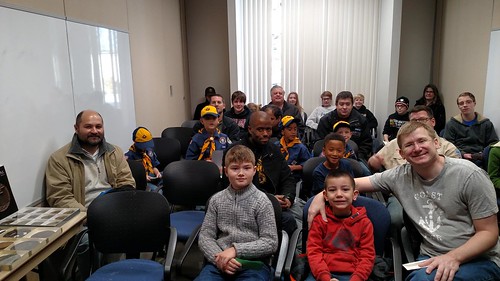
Our program was a panel session, with each of us talking a few minutes about how we got started in collecting, what interests us and how our collecting journey has changed. It seemed to work well and we got good questions from the audience.
Several kids came up to look at the lots before the auction. the room was quite crowded, but we made do. Here's a shot of Jon Radel calling the auction, with Tom Kays seated behind.
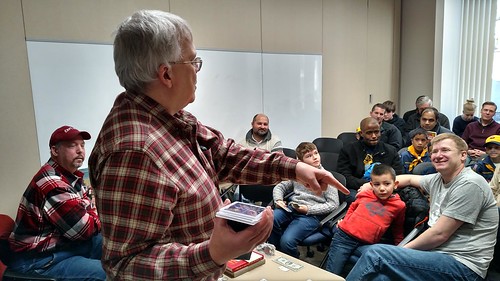
I acted as the auction runner for most of the sale, taking lots to the winner and collecting their auction dollars. I excused myself and took an early leave with many things left to do at home on weekend when our kids had three basketball games and our daughter had a chorus concert. Somehow I managed to produce The E-Sylum in between it all.
Party Time
Tuesday December 13, 2016 was the annual Nummis Nova holiday dinner. Spouses are invited and we keep numismatic talk to a minimum. Dave Schenkman and Brandenburg were our hosts, and they chose
Gadsby's Tavern in Alexandria, VA. Consisting of two buildings (a circa 1785 tavern and the 1792 City Hotel), the establishment at 138 N. Royal Street hosted meetings and social events; among its
guests were George Washington, Thomas Jefferson, John Adams, James Madison & James Monroe. Washington frequently visited the tavern, and twice attended the annual Birthnight Ball held there in his
honor.
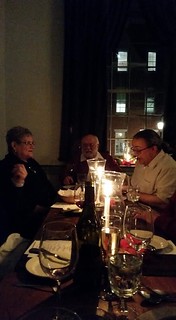 I arrived a little early but guests were already starting to trickle in. Only one table was occupied, and I sat down next to Eric Schena, whose wife Heather was home sick. Also at my table
were Gene and Amelia Brandenburg, Dave and Joanne Schenkman, and Joe and Hope Esposito. Gene kindly bought a round of champagne and wine. Joe took this shot of our table showing Amelia, Gene, and
Eric Schena.
I arrived a little early but guests were already starting to trickle in. Only one table was occupied, and I sat down next to Eric Schena, whose wife Heather was home sick. Also at my table
were Gene and Amelia Brandenburg, Dave and Joanne Schenkman, and Joe and Hope Esposito. Gene kindly bought a round of champagne and wine. Joe took this shot of our table showing Amelia, Gene, and
Eric Schena.
Other attendees were Joe and Alice Levine, Wayne and Karin Herndon, Howard and Phung Daniel, Julian and Fran Leidman, Jon Radel, Aaron Packard, Steve Bishop, Lenny Goldberg and his guest Dale Brown, and Tom and Dot Kays.
Joe Esposito writes:
As was the case at last year’s holiday dinner there was an appearance of the excellent (and witty) reenactor John Douglas Hall, who portrayed an early 19th century Alexandria resident. Here’s Hall as James Madison: https://www.c-span.org/video/?299215-1/president-james-madison-gadsbys-tavern
We had a lot of great conversations. At my table topics ran the gamut from our families to DC-area resident billionaires Paul and Bunny Mellon. I tried to get up and mingle a bit, but still didn't manage to see everyone. Just one numismatic display to report - an unusual Peace Dollar brought by Joe Esposito.
Here are a couple photos by Eric Schena. Thanks. Remember, we were dining in the 18th century style - by candlelight.
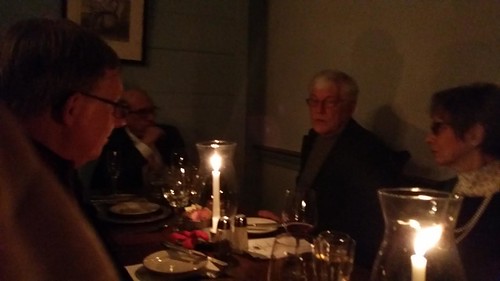
Wayne, Joe, Dave and Joanne Schenkman
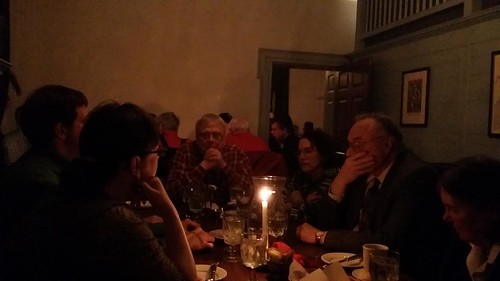
Karin and Wayne Herndon, Jon Radel, Dale Brown, Joe and Alice Levine
U.S.S. Marblehead Peace Dollar
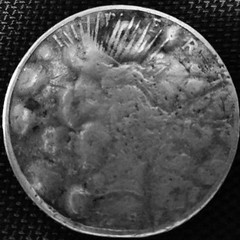
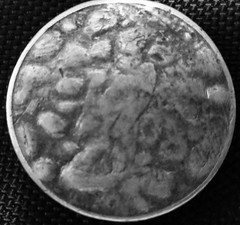
Joe writes:
While my numismatic interests have moved to other areas, I still look for unusual silver dollars. I bought one at a coin show in Fairfax, Virginia on December 11. It is a 1923 Peace dollar which was found on the U.S.S. Marblehead before it was scrapped in 1946. This light cruiser saw action in World War II, notably at the Battle of Makassar Strait in the then Dutch East Indies in 1942. It was badly damaged during that battle. This silver dollar has been damaged, too. It’s unclear what happened, but the coin has significant bubbling, perhaps from intense heat. It’s an unusual artifact.
As always, it was a great night of fellowship. I ducked out a bit early. My wife had taken our son to his basketball practice, and it was my job to pick him up. I managed to get there with 15 minutes to spare. But my belly was full. The Chicken Cordon Bleu was so large I commented that it might really be an ostrich. Thanks again to Gene and Dave for organizing the event.

GOLDBERG ANCIENT JEWISH COINS 2017 NYINC SALE
at New York Waldorf Astoria Hotel on January 10
One of the most extensive collections of extraordinary high quality ancient Jewish coins, assembled by a Long Island Doctor over two decades, will be auctioned at the Waldorf Astoria Hotel on January 10th. Included are a remarkable number (45) of extremely rare silver coins picturing the Holy Temple in Jerusalem, minted just 60 years after the Temple had been destroyed in 70 CE. Each of these museum quality approximately quarter dollar size silver coins pictures the interior of the Temple, including the Ark of the Covenant surrounded by columns, usually with a star above—thought to refer to the Jewish leader Simon Bar Kochba (Simon Son of the Star), who was proclaimed the Messiah by Rabbi Akiva, and whose name, in ancient Hebrew, surrounds the Temple. The other side of the Temple coins features lulav and etrog, along with Hebrew inscriptions like “For the Freedom of Israel.” The auction company estimates that most of the Holy Temple coins will sell for $5,000 and up.

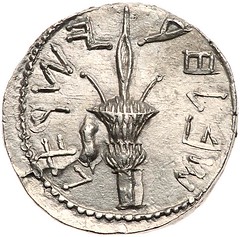
Bar Kochba Revolt Year Two Temple Sela, 133/4 CE
The Holy Temple coins and others were issued by Simon Bar Kochba beginning in 130 CE when he led a revolt upon learning that the Roman Emperor Hadrian planned to build a temple on the holy Temple site dedicated to the god Jupiter (Zeus). When the Jews watched the stones of the Sanctuary being used to erect temples for heathen gods, no choice was left to them but to interrupt the building of the Roman colony by force of arms before it was completed. But the might of Rome was too much for the Jewish freedom fighters, and the coins issued by Bar Kochba in the third year of the conflict (133/4 CE were the last Jewish coins struck in the Holy Land until the establishment of Israel in 1948.
The Roman and Greek overlords of Judaea did not allow their Jewish subjects to strike silver coins, so the only silver coins issued were during the Bar Kochba Revolt (130-134 CE) and the First Revolt (66-70 CE), when the famous Judaean Shekels were made. The Brody Family Collection contains a Shekel and a Half Shekel from each of the first three years of the Revolt, and the extremely rare Shekel from the fourth year, each in Extremely Fine to unbelievable Mint quality. The catalog indicates that the Year Four Shekel is “Among the finest known examples,” and it is estimated at $30,000.
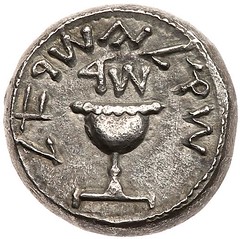
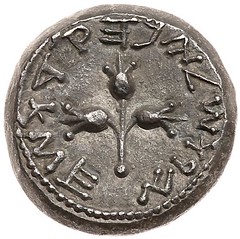
First Revolt Year Four Shekel, 69/70 CE
No first tier ancient Jewish coin collection should lack the famous Menorah coin issued in the last days of the Hasmonean King Mattathias Antigonus, when the kingdom was about to pass into the hands of Herod the Great (c. 37 BCE). Brody’s small bronze “prutah” features the Table of Shewbread on the other side, and is estimated to bring a minimum of $25,000. Other bronze prutahs issued by the earlier Hasmonean rulers beginning in 134 BCE feature double cornucopiae, anchors, etc.—but never a portrait due to the commandment against graven images—carry auction estimates as low as $150.
The ancient Jews never struck a gold coin, but the nation of Judaea was referred to on gold (as well as silver and bronze) coins issued by the Romans following the defeat of Judaea and the destruction of the Temple in 70 CE. The cataloguer describes one of the gold aureus specimens as “Marvelous.” This Judaea Capta type features a bold “IVDAEA” inscription beneath a seated female figure in the attitude of mourning, and a portrait of the Emperor Vespasian, who also led the Roman troops against the Judaean freedom fighters. It is expected to be hammered down for over $60,000.
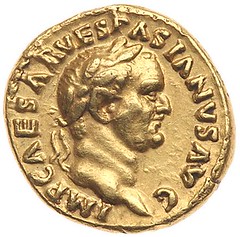
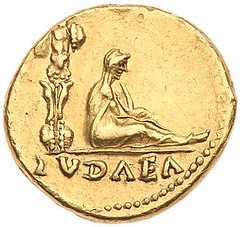
Judaea Capta Aureus 69/70 CE
Whether you are interested in Jewish history or might want to add ancient Jewish coins to your Judaica collection, all 238 lots of the Brody Family Collection can be viewed on the website of Goldberg Auctioneers at www.goldbergcoins.com/view-auctions/catalog/id/53 You can also register to bid at www.goldbergcoins.com/login, and you can view the actual coins at the Waldorf Astoria Hotel (Norse Suite) on January 9-10 before the sale at 7:00 PM on January 10th. For questions or to order a catalog, call (310) 551-2646; mention where you read this and cost is only $15 (regularly $30).
NEWMAN COLLECTION COLONIAL CURRENCY MONOGRAMS
Mesmerizing Monograms in Newman Internet Part 2
The April 2, 1776, North Carolina issue features 56 distinct types ranging in denomination from $1/16 to $20. This issue’s multiple denominations, interesting folk-style engraved vignettes, and unusual and somewhat mysterious monogram notes combine to make it one of the most interesting and diverse series of Colonial Currency.
Eric P. Newman attained all six monogrammed types, a very rare achievement. These intriguing notes are featured in the Newman Collection Internet-only Part 2 auction currently open for bidding on the Heritage website at HA.com/241622 .
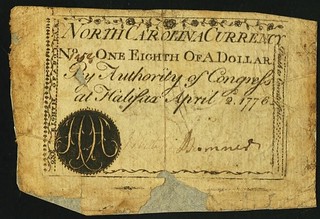
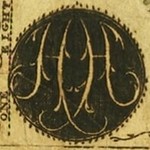
Lot 90166: North Carolina April 2, 1776 $1/8 Monogram with Regular and Mirrored H Fr. NC-154d.
www.HA.com/241622-012189
The “Mirrored H” monogram type is exceedingly rare and one of the hardest to find of the 56 April 2, 1776 types. The fact that it was missing from the F. C. C. Boyd Collection makes the rarity quite evident. This has a very sharply printed monogram at the lower left.
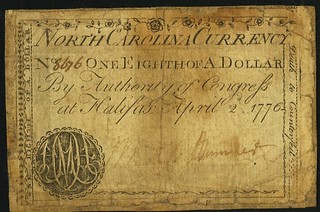
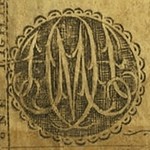
Lot 90167: North Carolina April 2, 1776 $1/8 JM Monogram Fr. NC-154e.
www.HA.com/241622-012190
Another exceedingly rare low-denomination type with an unusual monogram at the lower left. The “JM” monogram also uses a mirrored image style with the lettering in white on a darker background. This type was also missing from the comprehensive Boyd Collection. Though 12,500 were authorized, few still exist.
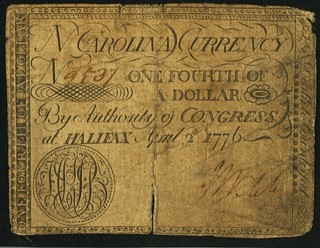
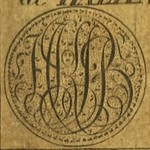
Lot 90168: North Carolina April 2, 1776 $1/4 FB in Black Script Monogram Fr. NC-155d.
www.HA.com/241622-012191
Another rare low-denomination type with a circular “FB” monogram at the lower left. The interlocking (or intertwined) initials are in black on a light background. The diminutive face at the center of the monogram may have served as a secret mark to deter counterfeiters.
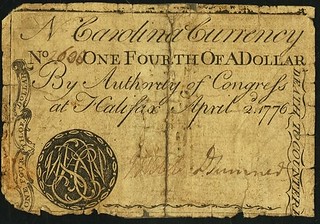
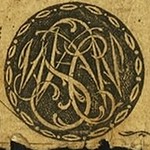
Lot 90169: North Carolina April 2, 1776 $1/4 NCSN in White Script Monogram Fr. NC-155e.
www.HA.com/241622-012192
This is a second $1/4 denomination. The circular interlocking (or intertwined) monogram is in white on a dark background. The arrangement of the letters suggests the boldly printed monogram is “NSCN.” The first “N” is reversed, the “S” is dominant in the center, the “C” is next, and finally, a forward “N” is at the right.
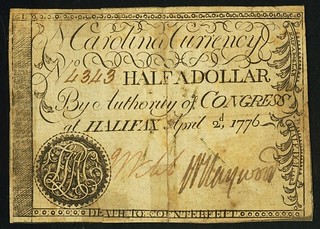
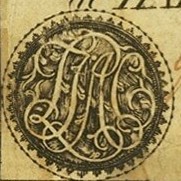
Lot 90170: North Carolina April 2, 1776 $1/2 LAC? in White Script with Toothed Border of Triangles Monogram Fr. NC-156e.
www.HA.com/241622-012193
This is the first of two $1/2 notes with monograms and engravers initials in the upper left corner. The lower left monogram is intricate, and the letters appear to be "LAC" in white on a dark background. Around the perimeter is a toothed border of triangles. A horizontal "GL," for silversmith Gabriel Lewyn, appears in Roman type at the upper left corner. This rare type was missing from the Boyd Collection. Noted with "Splits and Minor Damage; Tape Repairs on Back." The face is bright and the note maintains excellent eye appeal.
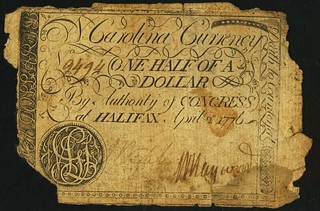
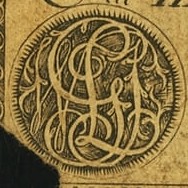
Lot 901701: North Carolina April 2, 1776 $1/2 GL in White Script with Toothed Border of Radial Lines Monogram
This second style $1/2 monogram note is the last of six different types. The interlocking monogram lettering appears to be “GL” in intricate white letters on a dark background, but this has not been specified in the Newman reference. This seems logical since there is a script “GL” (Gabriel Lewyn) monogram perpendicular on this type at the upper left. The Roman letter “GL” monogram also appears on four other notes in the series: $2 Fox, $5 Triton, $7-1/2 U. S. Flag, and $20 Rattlesnake. Like all the fractional notes, rare and difficult to obtain in high grades.
Except for the “GL” discussed above, we are unaware of the significance of the initials in the other five North Carolina monogrammed notes. We would be most appreciative of any information that sheds light on the significance of these mesmerizing monograms.
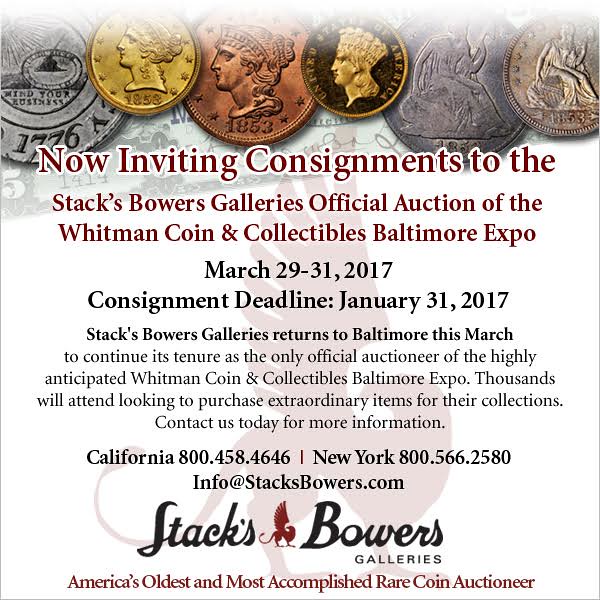
LAWSUIT DETAILS ISLAMIC STATE COIN SALES
A lawsuit filed in the nation's capital provides a window into how the Islamic State group finances its operations, sometimes one ancient gold coin at a time.
The lawsuit filed Thursday in federal court in Washington seeks to recover four ancient artifacts — a ring, two gold coins and a stone tablet — worth thousands of dollars that are believed to have been put up for sale by the group. Prosecutors said one of the goals of filing the lawsuit, which uses a law that allows the U.S. government to go after the foreign or domestic assets of terrorist groups and is believed to be the first of its kind targeting the Islamic State, is to decrease the market for objects being sold by the militant organization.
"We're hoping that the market truly gets depressed," said Arvind Lal, the head of the Asset Forfeiture and Money Laundering Section of the U.S. Attorney's Office for the District of Columbia.
The information that forms the basis of the lawsuit comes from a May 2015 U.S. raid in Syria in which an IS leader, Abu Sayyaf, was killed. Documents from the raid show Sayyaf was the president of the IS Department of Antiquities.
The lawsuit says that Sayyaf sold antiquities and the money was turned over to the Islamic State group. Documents recovered during the raid say Sayyaf had the power to allow people to dig for archaeological objects in IS-controlled territories as well as arrest people excavating archaeological objects without his department's authorization.
The Islamic State group also allegedly received at least 20 percent of the proceeds of items excavated from archaeological sites under its control and taxed antiquities sold in its territories. At one point, a child was kidnapped to force an antiquities merchant to pay, the lawsuit says.
The lawsuit says that antiquities, including hundreds of coins, were found in Sayyaf's possession during the raid. The items "appeared to have been in the process of being sold internationally," the lawsuit says. Items recovered during the raid were later returned to the government of Iraq, the lawsuit says.
Now, the U.S. government is going after four items, pictures of which were recovered on a hard drive and cellphone during the raid. The items were photographed to be sold, but the lawsuit did not say does not say where items may be now.
The lawsuit seeks to recover a ring, two ancient Roman gold coins and a stone slab that contains the carving of a figure and ancient writing.
To read the complete article, see:
Lawsuit Details Islamic State Profits From Antiquities' Sale
(www.nytimes.com/aponline/2016/12/15/us/politics/ap-us-islamic-state-gold-coin-lawsuit.html?_r=0)
MACNEIL'S STANDING LIBERTY QUARTER BRONZE CAST
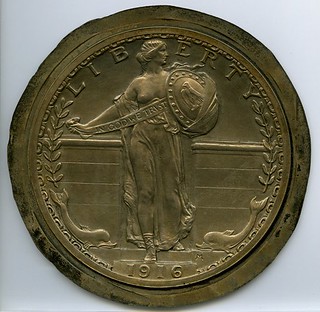 One of the more singular pieces it has been our privilege to offer recently is an Original Bronze Cast of the Standing Liberty Quarter Obverse (lot ID 181001), roughly 150 mm in diameter
and believed to be unique in private hands. This is among the rarest artifacts related to the widely popular Standing Liberty quarter series, an original bronze cast of Hermon MacNeil's obverse
design as it appeared in August 1916. Few other relics of the Standing Liberty quarter's design production period survive in private hands, and arguably none harbor the appeal of this large
bronze cast of the obverse design. This artifact will be offered in our January 4-9 FUN Signature Auction.
One of the more singular pieces it has been our privilege to offer recently is an Original Bronze Cast of the Standing Liberty Quarter Obverse (lot ID 181001), roughly 150 mm in diameter
and believed to be unique in private hands. This is among the rarest artifacts related to the widely popular Standing Liberty quarter series, an original bronze cast of Hermon MacNeil's obverse
design as it appeared in August 1916. Few other relics of the Standing Liberty quarter's design production period survive in private hands, and arguably none harbor the appeal of this large
bronze cast of the obverse design. This artifact will be offered in our January 4-9 FUN Signature Auction.
The imagery on this cast differs dramatically from MacNeil's original obverse models. In late June 1916, the sculptor began making adjustments to his design in the interest of sharpening details and increasing the aesthetic appeal. But the result was a drastic redesign of the entire obverse. The figure of Liberty was completely remodeled and brought up in sharp relief, and the inscription LIBERTY above her head was strengthened in definition and reduced in size. The shield rivets were more widely spaced, and the inner shield was replaced with an eagle. IN GOD WE TRUST migrated from the gateway walls to the sash drawn across Liberty's torso, and the walls themselves were simplified in their design. Liberty herself was given sandals, and the drapery was drawn up tighter around the shield. Dolphins representing the Pacific and Atlantic Oceans were added to each side of the date, accompanied by branches of laurel. The olive branch of peace disappeared from Liberty's outstretched hand, and her hair was restyled to flow in the wind. A chain-like border surrounded the periphery in place of the previous dot-and-dash pattern. The modified design showcased a captivating beauty that the former did not fully deliver.
A bronze cast of MacNeil's modified design was delivered to the Mint on September 9th, 1916. However, it was never produced in coin form. During the correspondence about the placement of MacNeil's monogram, the Mint was experiencing striking problems with the new Mercury dime, unable to get the coins to stack properly due to thickness issues and a wire rim problem. Documentation presented by Roger Burdette in Renaissance of American Coinage suggests that when the bronze cast of the quarter obverse arrived at the Mint, Chief Engraver Charles Barber examined it and discovered that working the model up to the mechanical requirements of the Mint would consume far too much time. Thus, Barber was instructed to revert to the original model for the obverse, which required far less modification to meet the Engraver's strict technical requirements. It was that design which later appeared on the mass production of December 1916.
Cataloging this piece in the Minot Collection catalog in 2008, Burdette stated: "One bronze cast reached the Philadelphia Mint. Another, the present example, must have remained in MacNeil's College Point, NY studio – a backup in case the first one were lost or damaged." As J.H. Cline notes in Standing Liberty Quarters, fourth edition, MacNeil's studio housed "a lifetime collection of complete sculptures, completed designs, partially completed works, and some of Hermon's most treasured works – either in picture form or the original castings." It would only make sense for the artist to retain a casting of what he believed would be the finished quarter dollar design.
It is thought that this bronze cast was among the artifacts recovered from MacNeil's studio after the sculptor's passing in 1947, by John A. Coughlin, a neighbor and professional illustrator. Coughlin is also credited with the preservation of several flying eagle sketches for the reverse of the quarter, later showcased in the Newman Money Museum, as well as MacNeil scrapbooks and letters preserved in the Smithsonian.
This cast, along with a similar bronze cast of a proposed reverse design, first came to light for collectors in 2008, when offered consecutively in Stack's Minot Collection sale, after reportedly being found at a garage sale in 2001. It appears plated in a light metal, possibly a nickel alloy, as noted by Burdette. The surface preservation is exceptional, with uniform silvery-bronze color and satin luster. For the Standing Liberty quarter specialist, about the only thing more exciting than having a chance to admire MacNeil's intended obverse design, is having a chance to acquire the original bronze casting. This piece is plated in Burdette's Renaissance of American Coinage, 1916-1921 (2005), and Q. David Bowers' Guide Book (2015).
To read the complete lot description, see:
1916 Standing Liberty Quarter Obverse Bronze Cast
(https://coins.ha.com/itm/standing-liberty-quarters/1916-standing-liberty-quarter-obverse-bronze-cast-uncertified/a/1251-5616.s)

2014 'MULE' BRITANNIA ERROR £2 BULLION COINS
A RARE £2 coin could be worth as much as £350 due to a small error made during the minting process.
There are thought to be around 17,000 of the “Mule Britannia” silver coin in circulation and the defect which makes it valuable could be easily missed.
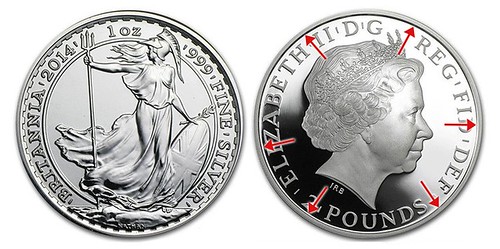
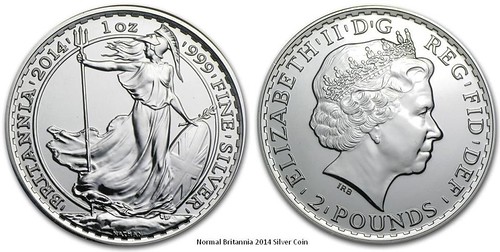
You can identify the coin by checking the front face, a portrait of the Queen, to see if the rim is missing dents.
Coin fans on eBay have been paying as much as £350 on eBay for the £2 Mule Britannia, according to completed listings on the auction site.
Although, some savvy collectors have snapped it up for as little as £60.
To read the complete article, see:
CHECK YOUR PURSE This rare 2014 £2 coin is worth £350 and there are 17,000 of
them (www.thesun.co.uk/living/2396633/this-rare-2014-2-coin-is-worth-350-and-there-are-17000-of-them/)
Approximately 17,000 examples of the 2014 Britannia 1-ounce silver £2 coins were struck with an obverse die intended for the Royal Mint’s inaugural Lunar bullion issue, celebrating the Year of the Horse in 2014. In addition, an estimated 38,000 examples of the Year of the Horse 1-ounce silver £2 coin were struck with an obverse die intended for the Britannia £2 coin.
A “mule” in coinage results when two dies not intended to be paired together are used to strike coinage. The word “mule” plays off the animal that is the offspring of a male donkey and female horse.
The Ian Rank-Broadley effigy of Queen Elizabeth II graces the obverse of both versions of both coins. A generally tiny but significant detail on the obverse makes the difference.
On standard examples of the Year of the Horse coin, no dentils are found about the rim; the standard Britannia coin has dentils. All Britannia coins are supposed to have dentils inside the rim on both sides of the coin, while both sides of the Year of the Horse coins are designed without dentils.
The Royal Mint confirmed the existence of both error coins, though an official did not specifically refer to either piece as a “mule.” Calling the dentils “edge decoration,” Jenny Manders, a spokesperson for the Royal Mint, released a statement noting that, “Some of our recent bullion customers may have noticed a slight change in the design of the edge decoration of our UK 2014 £2 Britannia bullion coin, and the UK 2014 £2 Lunar bullion coin. ... The quality and value of the coins remains the same.”
As with other mule coins, the value of the errors is considered much higher than the standard versions of the respective coins.
To read the complete article, see:
'Mule' Britannia: error versions of silver £2 coins surface
(www.coinworld.com/news/world-coins/2014/03/mule-britannia-error-versions-of-silver-2-coins-surface.all.html#)
PILOT LUIS PARDO'S SHACKLETON EXPEDITION MEDALS
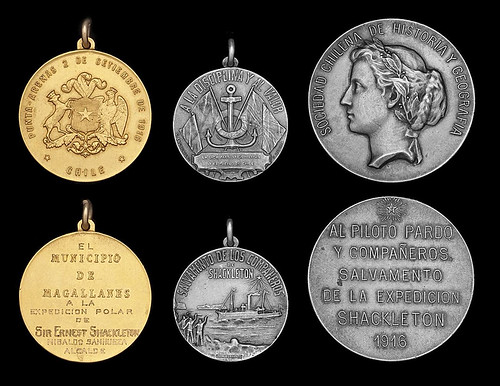
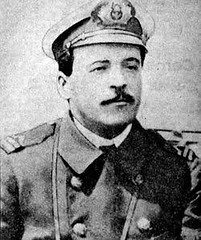 This set of three medals was awarded by the Chilean government to the Chilean pilot, Luis Pardo, who rescued Shackleton and his men from their doomed expedition at great risk to himself.
Only three of the gold medals are said to have been awarded, the other two being to Shackleton himself and to Frank Wild, Shackleton's second-in-command. Shackleton's medal has been lost, and
the whereabouts of Wild's medal are unknown, which makes this gold medal the only one known to exist today.
This set of three medals was awarded by the Chilean government to the Chilean pilot, Luis Pardo, who rescued Shackleton and his men from their doomed expedition at great risk to himself.
Only three of the gold medals are said to have been awarded, the other two being to Shackleton himself and to Frank Wild, Shackleton's second-in-command. Shackleton's medal has been lost, and
the whereabouts of Wild's medal are unknown, which makes this gold medal the only one known to exist today.
Pilot Pardo was later offered a large monetary reward by the British government, but humbly turned it down, saying he was only doing his duty. Today this set belongs to a renowned Chilean collector residing in Santiago.
To read the earlier E-Sylum articles, see:
ANTARCTIC EXPLORER'S MEDAL OFFERED (www.coinbooks.org/esylum_v19n49a24.html)
SOUTH GEORGIA SHACKLETON EXPEDITION COIN (www.coinbooks.org/esylum_v19n50a24.html)
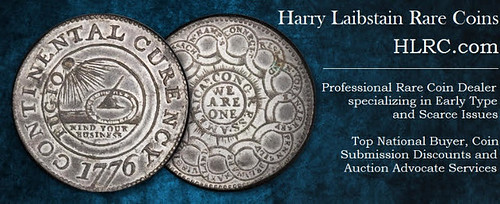
CLYDESDALE BANK NOTES
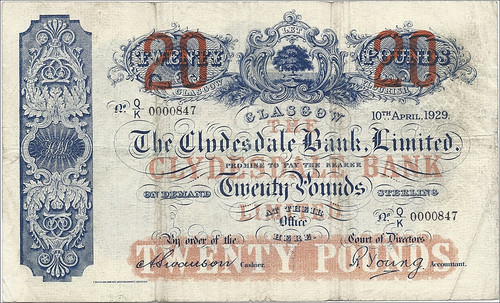
Clydesdale Bank One Pound
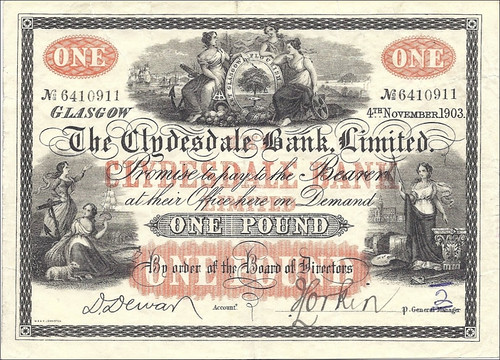
Clydesdale Bank Twenty Pounds
To visit Pam West's web site, see:
http://britishnotes.co.uk/
VENEZUELA WITHDRAWS LARGEST BANKNOTE
 Not long ago, Yajaira Perez was queuing to withdraw cash from the bank, fearing bills would run short. Now she is queuing anxiously to put it back in.
Not long ago, Yajaira Perez was queuing to withdraw cash from the bank, fearing bills would run short. Now she is queuing anxiously to put it back in.
Venezuela’s food, medicine and currency crisis is now a cash crisis, too, with the government about to put millions of bank notes out of circulation.
As usual, ordinary Venezuelans are suffering — waiting in line for hours to deposit the doomed bills, when they could be working, or caring for their families.
“It’s horrible, horrible. They can’t do this a few days before Christmas,” said Ms Perez, a middle-aged housewife while queuing in the early morning at a bank in eastern Caracas.
Spooked by a shortage of banknotes, she had been withdrawing 100 bolivar bills to make sure she had ready cash.
Then on Monday (AEDT), President Nicolas Maduro ordered the most common bank note, the 100-bolivar unit, to be scrapped by Friday. “Little by little you put money aside in case of an emergency,” Ms Perez said. “Now I have to come back and I’m ending up with no cash at all.”
Teresa Giraldo, 48, has been getting paid mainly in 100-bolivar bills for her job as a cleaner.
“I went to buy bread and when I got to the front of the queue they wouldn’t accept them,” she said.
“Now I have to go through this to put them in the bank. Then I will have to come back in a few days and queue for more hours to withdraw the money again. This is crazy.”
The 100-bolivar bill is the highest-denomination bank note in Venezuela, but is worth about a US1c. In a country with one of the highest rates of violent crime in the world, shoppers must carry round unwieldy wads of bills to pay for their purchases.
To read the complete article, see:
Venezuelans queue to deposit cash
after largest banknote is axed (www.theaustralian.com.au/news/world/venezuelans-queue-to-deposit-cash-after-largest-banknote-is-axed/news-story/4f6c3fbf05497445695930ec26fe4183)
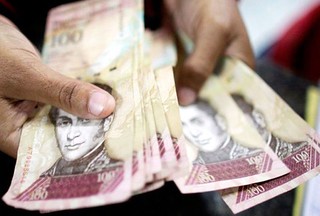 Authorities on Thursday are due to start releasing six new notes and three new coins, the largest of which will be worth 20,000 bolivars, less than $5 on the streets.
Authorities on Thursday are due to start releasing six new notes and three new coins, the largest of which will be worth 20,000 bolivars, less than $5 on the streets.
Maduro, a former bus driver and union leader elected after Chavez's death in 2013, said Colombian shoppers and organized criminals were buying up the 100-bolivar bills to go on a spending spree in Venezuela, worsening shortages of basics such as flour and antibiotics.
Venezuela is heaving under its third straight year of recession, pushing millions to skip meals and medical treatment. Many others are increasingly traveling to Colombia to find supplies. But shops across the border on Monday were displaying signs that they would not accept 100-bolivar bills, bringing business to a halt and sending Venezuelans home empty-handed.
Later on Monday night, Maduro announced in a televised broadcast that he would close the porous border for 72 hours to stem what he said was contraband of notes. His government also says businessmen are hoarding goods and bloating prices to sabotage socialism.
In Venezuela, there also were logistical concerns about how authorities would remove the more than six billion 100-bolivar bills in circulation, nearly half of all coins and notes, and whether replacement bills were ready.
To read the complete article, see:
Chaos in Venezuela: bills and coins pulled out of circulation to
combat hyperinflation (http://en.mercopress.com/2016/12/13/chaos-in-venezuela-bills-and-coins-pulled-out-of-circulation-to-combat-hyperinflation)

AUSTRALIA MULLS ELIMINATION OF $100 BANKNOTE
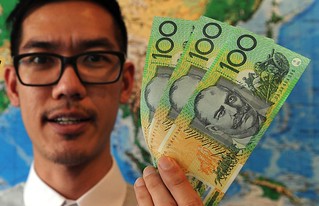 The future of the $100 banknote could be cut short as the Turnbull government tries to find billions for budget repair.
The future of the $100 banknote could be cut short as the Turnbull government tries to find billions for budget repair.
At the MYEFO next week the government is expected to announce a taskforce, headed by former KPMG global chairman Michael Andrew, to target the cash economy which accounts for 1.5% of GDP, or $21 billion, in money that goes untaxed.
As part of that the $100 note and a ban on cash payments over a certain limit could be axed.
“There’s nothing wrong with cash, the issue is when people don’t declare it,” said revenue and financial services minister Kelly O’Dwyer.
“If we can get a percentage of that, it’s revenue owed to the Australian people.”
O’Dwyer said the taskforce will look to countries such as France, where the government is banning cash payments of over 1000 euros, and Sweden, where businesses that trade in cash are required to use a certified cash register that provides real-time information to the Swedish tax authorities.
Currently $50 notes and $100 notes represent 92% of the cash in circulation, according to Reserve Bank figures.
Last month Indian prime minister, Narendra Modi, scrapped 500- and 1,000-rupee banknotes from circulation, wiping out 86% of India’s currency overnight.
Last week Venezuela also demonetised its largest bank note, replacing it with the same value coin.
To read the complete article, see:
The $100 banknote could be on the chopping block
(www.businessinsider.com.au/the-100-banknote-could-be-on-the-chopping-block-2016-12)
THE BOOK BAZARRE
ARTIST SPENDS BILL ENGRAVED WITH MICRO-PORTRAIT
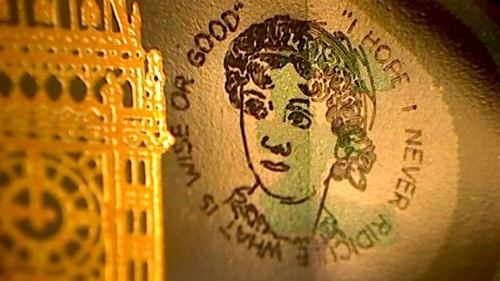
Specialist micro-engraver Graham Short engraved a tiny portrait of Jane Austen on the fiver and used it to pay for a sausage and egg sandwich in a cafe in Blackwood, Caerphilly county.
Mr Short's office confirmed the note was found in south Wales, but said its new owner wanted to remain anonymous. The lucky finder said she intended to give it to her granddaughter as an investment for when she grows up.
This fiver was engraved with: "A large income is the best recipe for happiness I ever heard of", a quote from Mansfield Park, and has the serial number AM32 885553.
Three other £5 notes - spent at a pie shop in Leicestershire and two other shops in Scotland and Northern Ireland - have not yet been discovered.
Mr Short said his work usually sells for about £100,000 and the notes were insured for £50,000 each.
He spent it at the Square Cafe at 14:30 GMT on 8 December and chose the valleys town as it is where his mother was born in 1909.
Mr Short, who is from Birmingham, said: "Generally this artwork is out of the reach for most people. I wanted an ordinary man or woman to find it in their hands. "I was hoping that the lady wouldn't check it when I gave it to her - which she didn't - because I wanted it to go into somebody's change."
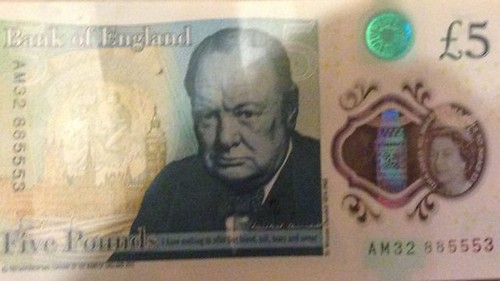
To read the complete article, see:
£5 note 'worth £50,000' spent in Blackwood is found (www.bbc.com/news/uk-wales-38333438)
ARTIST ENGRAVED QUEEN'S PORTRAIT ON PINHEAD
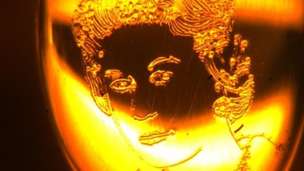 An artist who engraved a minute picture of the Queen on a pinhead said he used Botox and pills to help him keep still.
An artist who engraved a minute picture of the Queen on a pinhead said he used Botox and pills to help him keep still.
Graham Short, from Birmingham, carried out the engraving to mark the Jubilee celebrations later this year.
He said it took 90 attempts over nine months to engrave the portrait on the 2mm wide pin.
To carry out the intricate work, he said he had courses of Botox around his eyes to keep them "rigid" as well as taking tablets to slow his heart rate.
Other minute work he has completed includes engraving the entire Lord's Prayer on a pinhead and the first chapter of the Koran on a 2mm platinum pin.
He said he swims 10,000m a day to achieve a "low resting pulse rate" and to be "perfectly still" when working under a powerful microscope.
He also does his etching between midnight and 05:00 to avoid any traffic vibrations.
Mr Short, who lives in Bournville and has had an engraving business in the Jewellery Quarter area of Birmingham since 1974, hopes his latest work will go on display.
To read the complete article, see:
Artist uses Botox to help engrave Queen portrait on pinhead
(www.bbc.com/news/uk-england-stoke-staffordshire-17906467)

LEIDMAN'S 1916 MCKINLEY GOLD DOLLAR HUNT
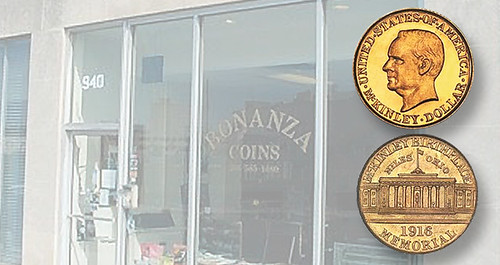
The following news release was issued by Bonanza Coins in Silver Spring, Md. Professional numismatist Julian Leidman says the coin that is the subject of the hunt is circulated, with a jewelry mount on the edge, and is valued at approximately $300.:
Want to win a 1916 McKinley commemorative gold dollar coin? Bonanza Coins' Holiday Treasure Hunt is for you!
In celebration of the 100th anniversary of the minting of the scarce 1916 McKinley commemorative gold dollar coin, the Bonanza Coins Treasure Hunt offers you a chance to win a McKinley gold dollar now hidden somewhere in the DC Metro area.
Julian Leidman, owner of Bonanza Coins reports: "McKinley appears on 3 different issues of U.S. commemorative gold coins. Quite fascinating."
Beginning Monday, December 12, 2016, through December 22, 2016, clues will be available at Bonanza Coins and posted on https://www.facebook.com/Bonanza-Coins-290279734341382/?ref=aymt_homepage_panel, along with clues tweeted by @fancaster.
The winner will be announced on New Years Day.
To read the complete article, see:
A gold 1916 William McKinley dollar is hidden somewhere in the DC Metro area
(www.coinworld.com/news/us-coins/2016/12/on-the-hunt-for-william-mckinley-gold-dollar.html)
COUNTERFEITERS IN UNALASKA, ALASKA
 Police in Unalaska arrested and charged two men over the weekend for allegedly making counterfeit money.
Police in Unalaska arrested and charged two men over the weekend for allegedly making counterfeit money.
Officers got a tip about the alleged operation while investigating a burglary and theft. Search warrants were obtained for both suspects' homes, according to the public safety department.
"Counterfeiting supplies as well as some U.S. currency in $10, $20 and $100 denominations were found in Zablan's residence," the statement says.
It was the men's statements to police that form the basis of the state's charges. Hough said Zablan washed ink from real money, and used the faded bills and regular paper to produce counterfeits through photocopying; Zablan said he photocopied the money for about a month or two months and was "practicing and getting better," the charges say.
"(Zablan) said he does it for fun and has not tried to pass the bills off as real," the charges say. But his alleged partner in crime told police Zablan used the fakes to buy marijuana.
On the map, Unlaska is a tiny dot far off in the middle of strong seas. But somehow, a diverse group of people make this remote island home, and share its wonders willingly with visitors. Ounalashka Corporation, representing the original Unangan inhabitants of Unalaska, allows those with land use permits to hike around much of the remote and rugged landscape of the Amaknak and Unalaska islands.
Seemingly in the middle of nowhere, Unalaska is affixed geographically on the Aleutian chain, and historically in the midst of 10,000-year-old Unangan culture, and in the eras of Russian fur traders, Captain Cook, World War II, and of a commercial fishing industry that ranks above all others in the United States.
Unalaska, the small, wind-swept volcanic rock, draws researchers, tourists, adventurers, birders, World War II buffs, fishermen, and seasonal workers – so many that the population swells from about 4,000 in winter to nearly 10,000 in summer.
To read the complete article, see:
Unalaska (www.alaska.org/destination/dutch-harbor-unalaska)

WANTED: COLD CALLING PHONE POUNDERS
Cold Calling Phone Pounders Needed for Rare Coin Sales
Work Hard-Make Money!!
Put in the time and effort each day pounding the phone and dialing for dollars and you will EARN!!
Looking for Cold Calling Telemarketers/Sales Reps selling rare coins to our lead lists of coin collectors.
We are a new office in Farmington Hills. We are located On North Western Highway and Middle Belt next to Buddy's Pizza.
No industry experience necessary. BUT MUST have Cold Calling and Telemarketing Phone Experience and be able to manually dial out 300-400 calls per shift.
This is a "Dial for Dollars" 1099 COMMISSION Only Position.
Average coin sales reps in this industry make $1,000-$2000 per week. Top coin sales reps, once established with clients, can make anywhere from $5,000 to $15,000 a week.
All coins are certified. Huge income potential for you in this up and coming industry.
All leads provided by the company. Full-time and Part time positions available.
I shared this with Joel Orosz, who writes: "I'm sure that all of the great coin collections of the modern era--Brand, Eliasberg, Newman, Partrick, et. al.--were built by purchases made from cold calling phone pounders from an office located next door to Buddy's Pizza shop. And if not, they should have been!"
Thankfully I rarely get one of these calls, but I do have fun with them, asking for numismatic details they clearly have no clue about. Like the ad says, "No industry experience necessary." -Editor
Joel adds:
I just wish I could listen in on you playing with one of the guys when he calls, asking him questions about the diagnostics of hub versus machine doubling, or the finer points of identifying die progressions.
To read the complete article, see:
Cold Calling Phone Pounders Needed for Rare Coin Sales (Farmington Hills)
(http://detroit.craigslist.org/okl/sls/5916457199.html)
A Clinton County woman said her elderly father was recently swindled out of nearly $10,000 from on online coin collector site.
“Most of these scams are committed outside of the country — a lot of them are out of Nigeria and in places where we don’t have extradition or the ability to investigate,” said Richard Shelton, a detective with the St. Joseph Police Department.
The woman, who asked to remain anonymous, said her father made purchases through Liberty Coin Gallery. According to its website the company is based in Ronkonkoma, New York.
“We at Liberty Coin Galleries, pride ourselves on the success of our clients across the country and we are dedicated to helping them secure their portfolios and protect their finances for generations to come,” according to Liberty Coin Gallery’s mission statement.
She said her ailing 80-year-old father, who is a disabled veteran and former law enforcement officer, was easy prey for the “piranhas.”
“Old people live by themselves a lot of times and their phones don’t ring that often, so when it does, they immediately think it’s a friendly call,” she said. “These people are slick. They know how to worm their way in.”
She said he received an $1,990 order that he didn’t want, but did not return it within the 15 days grace period.
She said once he realized the coins were not worth what he paid, he asked the company to stop calling him. The woman, who lives in Plattsburg, Missouri, and works in St. Joseph, said her father lives in a retirement home in Gravois Mills, Missouri, and she monitors his finances, but cannot catch everything since he lives three and a half hours away.
The daughter also contacted Liberty Coin Gallery and asked them to cease calls to her father who is on the Do Not Call Registry. A representative told her they would honor her request, but the calls continued.
“They use computer-generated dialers,” Shelton said. “Once they answer the phone, they know it’s a legitimate number. Then that number can be sold.”
She said about 10 days later they shipped another order, which they did not accept, and charged $4,725 to a credit card he never authorized them to use.
“It’s a huge racket because most people don’t have the time and will to carry it out so they eat it. ... My dad is not a rich man,” the woman said. “It makes me mad. I can hardly talk about it.”
The woman said a credit card dispute was filed and the account was closed. The woman said if her father’s financial institution can substantiate the claim he could get the money back.
“There can be no substantiation. They are crooks,” the woman said.
To read the complete article, see:
Woman warns of online coin scam
(www.newspressnow.com/news/local_news/woman-warns-of-online-coin-scam/article_83c18b05-b46b-5ef9-96c8-71c7dccdf55f.html)
MORE AMAZING COIN STACKS
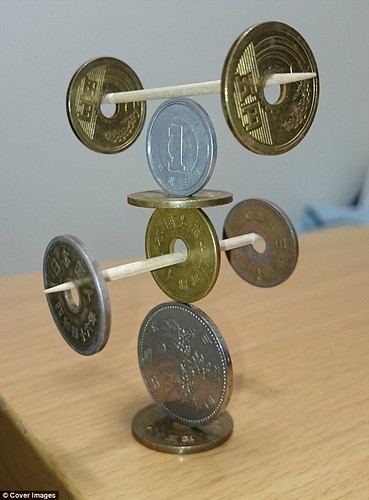
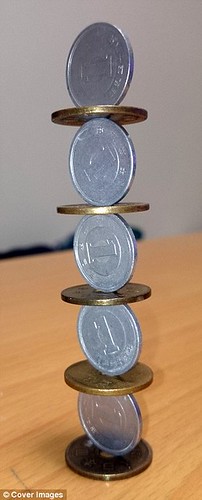
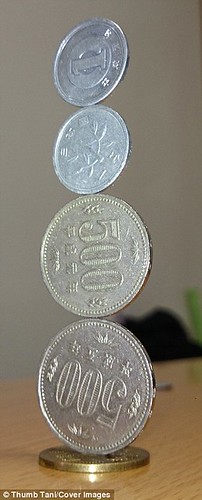
To read the complete article, see:
That’s one way to check your bank balance: Impossible-looking
formations created using coins (www.dailymail.co.uk/news/article-4028496/These-jaw-dropping-images-work-talented-obviously-patient-coin-balancer.html)
To read the earlier E-Sylum article, see:
AMAZING COIN STACKING VIDEOS (www.coinbooks.org/esylum_v19n50a36.html)
THE BOOK BAZARRE
HAPPY CHRISTMAS BOOK FLOOD
Pat McBride writes:
I saw this on Facebook. I checked the website that created the cool meme. I Googled the tradition and apparently it is real.
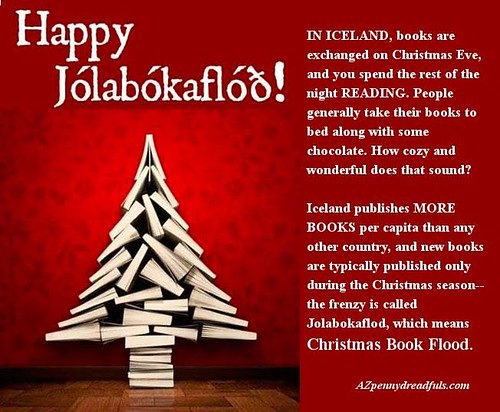
CHARLES DICKENS: A CHRISTMAS CAROL
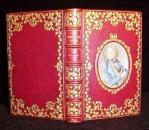 What do Christmas and rare vintage books have in common? The answer is …the famous first edition of the Charles Dickens book – A Christmas Carol. This immortal novel written by
Charles Dickens is easily one of the most loved Christmas stories ever written, while the scarcity of its first edition has given some fortunate book collectors a holiday to celebrate.
What do Christmas and rare vintage books have in common? The answer is …the famous first edition of the Charles Dickens book – A Christmas Carol. This immortal novel written by
Charles Dickens is easily one of the most loved Christmas stories ever written, while the scarcity of its first edition has given some fortunate book collectors a holiday to celebrate.
Very few people on this planet have never heard of the renowned Charles Dickens or of his A Christmas Carol. Charles Dickens was born at Landport, UK, on February 7th, 1812. After facing financial difficulties Dickens’ family moved to London in 1822. Shortly afterwards, in 1824, the family sent the then 12-year old Charles to a boarding house. However, Dickens soon left school to work 10 hours a day to support his struggling family. The harsh and cruel working conditions that Dickens had to face, greatly affected him. As a result he strove to make the injustice of these unacceptable and inhuman working conditions clear through his work to inspire the change towards a better working life.
Charles Dickens wrote his first story, A Dinner at Poplar Walk, in 1833 which he soon followed with Oliver Twist between the years 1837-39, Nicholas Nickleby between 1838-39, and many others. From 1833 all the way up to his death on June 9, 1870, Dickens wrote a great deal of novels and saw most of his works get published.
The famous novella A Christmas Carol was first published by Chapman and Hall on December 19th 1843. The book was written during depressing times in England, where the Christmas spirit had nearly been forgotten by many. Dickens hoped to rekindle the true Christmas spirit through the novel, with the portrayal of the cynical and stingy Ebenezer Scrooge and the changes he transitioned from in Christmases of his past, present and future.
Dickens started writing the novel, A Christmas Carol, in October 1843 and within six weeks, it was completed. Despite numerous obstacles with the book’s publication process, it was completed two days prior to its scheduled release date of December 19, 1943. The published book was an object of beauty, as it was bound in red cloth and filled with illustrations by John Leech. The book was priced at a scant 5 shillings, and was a raging success. The 6000 copies of the first edition actually ran out by Christmas Eve. By May of 1844 the book was already in its 7th edition, with increasing demand from the United States and receiving great reviews in the New York Times.
For a book collector, the first edition of the book is the ultimate possession to seek after. As expected pricing for first editions of this famous book is no bargain. Two copies of the first edition were sold in an auction in 2005 for the price of 15,000 USD. Surprisingly, neither of the two copies was in a very good condition. Currently, copies of this remarkable book are being sold by antiquarian and rare book sellers for anywhere from 19,000 to 40,000 USD depending on condition, unique attributes, seller geographic location, and so forth.
Inscribed presentation copies are reaching an even higher price range. In 1997 a copy which was inscribed to the British humorist and poet Thomas Hood, was sold for 50,000 USD. A year later, in 1998, a first edition copy inscribed to Walter Savage Landor, an English writer and poet, was sold for the astronomical amount of 160,000. The big difference in price is justified by the factors of condition and importance of association. More recently, a year ago, on October 28 2010, at a Sotheby’s auction in London UK, another copy sold at the astounding price of 181,250 GBP or 282,408. This copy was inscribed to Dickens’ good friend William Macready, a known British actor, and was dated and signed on New Year’s Day of 1844. This represents a 75% jump, within a 12 year timeframe from the previous sale of the comparable copy.
In the end, A Christmas Carol, has proven that a 5 shilling ( equivalent of 25 USD in today’s money ) investment in a rare and extraordinary legendary vintage book, can be worth between 20-40K USD, while an inscribed copy can reach 280K USD or more. But even more importantly, Charles Dickens has proven through the character of Ebenezer Scrooge that the true Christmas spirit is reached by an act of giving.
To read the complete article, see:
Charles Dickens Rare Book: A Christmas Carol
(www.rarebooksdigest.com/2011/12/22/charles-dickens-rare-book-a-christmas-carol/)
To read the original 1843 version of Dickins' A Christmas Carol, see:
A Christmas Carol (Dickens, 1843) (https://en.wikisource.org/wiki/A_Christmas_Carol_(Dickens,_1843))

NUMISMATIC REFERENCES IN A CHRISTMAS CAROL
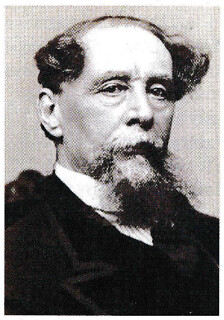 Charles Dickens' novella A Christmas Carol, first published in December 1843, enjoys undiminished popularity. Although Dickens reveled in the details of Christmas shopping, he
skimped on the details of monetary tiansactions. The reader is told about the scales, the twine and roller, the smell of tea and coffee, and the wicker shopping baskets, but never how much the items
cost.
Charles Dickens' novella A Christmas Carol, first published in December 1843, enjoys undiminished popularity. Although Dickens reveled in the details of Christmas shopping, he
skimped on the details of monetary tiansactions. The reader is told about the scales, the twine and roller, the smell of tea and coffee, and the wicker shopping baskets, but never how much the items
cost.
This omission was deliberate. Dickens disapproved of monetary transactions, relegating them to the world of the "old" Scrooge, that is, before the stingy character was transformed. The very items used to process monetary transactions, such as cash boxes, keys, padlocks, ledgers, deeds and healy purses, become the chain that weighs down Marley's ghost.
Money as a Metaphor
Coins in A Christmas Carol often serve as metaphors for something of little monetary value, like the American expressions "red cent" or "thin dime." Dickens refers to the
farthing, penny, twopence and sixpence in this way. After Scrooge's transformation, he pledges to provide food and fuel for the poor and declares he will donate "not a farthing less."
When Joe says that his offer is final, he explains, "If you asked me for another penny, and made it an open question, I'd repent of being so liberal and knock off half-a-crown." When
the Cratchits drink to Scrooge's health, Tiny Tim "didn't care twopence for it."
In A Christmas Carol, the sixpence appears twice. Joe, again presenting a final offer, says "I wouldn't give another sixpence, if I was to be boiled for not doing it." And Mrs. Cratchit appears "brave in ribbons, which are cheap and make a goodly show for sixpence."
A Generous Tip
When Scrooge sends a boy off to buy a gigantic turkey, he offers a generous tip: "Come back with the man, and I'll give you a shilling. Come back with him in less than five minutes, and
I'll give you half-a-crown!" A half crown (2 shillings, 6 pence), the largest silver coin in general circulation, was a magnanimous gratuity in the Victorian period.
Coins in the 1951 Movie Version
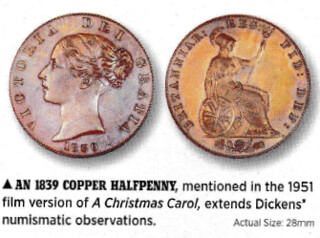 The best film treatment of A Christmas Carol is generally agreed to be the 1951 version starring Alastair Sim. The film adds two notable numismatic references to those of the novel.
The halfpenny appears as another denomination when Scrooge asks the waiter for "More bread!" The waiter responds that it would be a "halfpenny extra," whereupon the miserly
Scrooge decides to go without. The other numismatic instance transpires when Scrooge gives a coin to his char-woman, Mrs. Dilber, as a Christmas present, and she looks down in astonishment to see
'A guinea!"
The best film treatment of A Christmas Carol is generally agreed to be the 1951 version starring Alastair Sim. The film adds two notable numismatic references to those of the novel.
The halfpenny appears as another denomination when Scrooge asks the waiter for "More bread!" The waiter responds that it would be a "halfpenny extra," whereupon the miserly
Scrooge decides to go without. The other numismatic instance transpires when Scrooge gives a coin to his char-woman, Mrs. Dilber, as a Christmas present, and she looks down in astonishment to see
'A guinea!"
ANA members can read the complete article at:
/www.money.org/thenumismatist/digitalarchives
A CHRISTMAS COIN CAROL
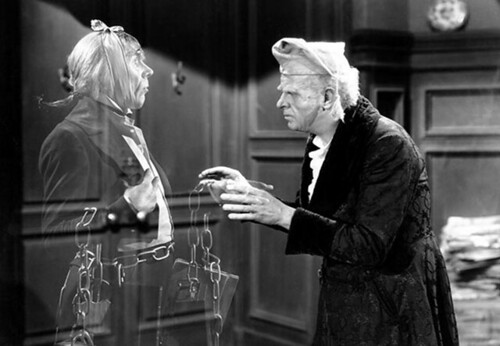
It was a cold Christmas Eve and Scrooge, had had a busy day. He had been buying Christmas coins for himself, at a Christmas Collectors’ Fair organised by his local numismatic society.
His evening meal consisted of a cheese and pickle sandwich. He had paid £2.99 with a new plastic banknote and got two a two-pound coin and a penny change. The penny was a new one. He would judge it to be GEF with some lustre. Technically it was not uncirculated as it had been in his pocket. The two-pound coin was a boring (to him) standard millennium issue. Just NVF.
Sidney read some catalogues before going to bed, including secondhand coin catalogue he had bought at a charity shop for £6.99 (paid with a twenty-pound note and got a ten pound note, two pound coins and a GF penny dated 1999 in return. He later noticed he was short changed but as it was a charity shop he did not mind so much but sent a stiff email. He then looked at a 1972 coin magazine he had found at the dentists’ and walked off with, thinking that as he was a patient he was entitled to it.
The short change incident played badly on his mind and his digestion and he settled down to a night’s insomnia. “Humbug” he said to himself and found a packet of humbug sweets. £1.20 paid with a pound coin and a twenty pence piece, which he did not check to see if it was the dateless variety.
His rest was disturbed by the poorly digested sandwich. In the small hours he gave up and turned the bedside light on to read his books. Being a simple soul he rubbed his eyes when he saw a figure in his room dressed in white. He thought at first it was the dentist claiming his magazine back. The figure explained that he was the Guardian Angel of Collectors and his role is to make sure numismatists have a Happy Christmas but only if they had been good. The angel told Sidney that he would be visited by three spirits throughout the night.
The first visit was at One O’clock. A figure appeared dressed in a three-piece tweed suit that must have dated from the 1960s. (Only about fine condition). Sidney had seen quite a few men dressed like that at the coin fair that day. The man explained he is the Ghost of Coin Collecting Past. He took him to a coin dealer. The shop was full of jolly, knowledgeable staff who were only too happy to leave him alone with trays of coins while the assistants went about their business. The whole storage room was full of catalogues and wooden cabinets and there were bags of coins on the floor. The coins cost only a few shillings. While Sidney was there letters arrived from school children with postal orders for five shillings and the staff were busy shovelling coins into return envelopes. Just as he was beginning to enjoy himself the scene changed and Sidney was back in his bed.
The next visitor was the Ghost of Coin Collecting Present who took Sidney to the local coin club celebrating their Christmas Party. The secretary had got a medallion made up to mark the 50th anniversary. He explained that they had had fifty struck and so far, sold eight. They were talking about possibly closing the society for lack of members. The society was an interesting collection of mainly more mature men, some with a few edge knocks, many had a patina of great age. The secretary was called Tiny Tim and looked in poor condition. Sidney was just about to make a comment on collecting when the scene changed again and he found himself back in his room.
He slept fitfully until disturbed by the final spirit, the Ghost of Coin Collecting Future. He was taken to what looked like a car park and he was standing in front of a ticket machine. He looked in his pocket for a coin to put in the machine to pay for his parking. There was a queue of people behind him all impatiently waiting to do same thing. Sidney had no change and asked if anyone had a hundred-pound coin for the slot. They all laughed and said no-one had coins and you had to stick your finger in the machine and it would take some of your DNA which you could have back if you did not overstay at the car park. This was a world of no coins at all, all dealers are all on line, no books, and no new collectors. Sidney wandered around the car park watching the people coming in and leaving. He reached down in the road as he thought he saw a coin on the ground. When he found it he looked at it. It was made of brown coloured plastic and commemorated King Charles, The Twentieth’s 150 years on the throne. While looking at it he did not see the hover car come around the corner and was about to hit him.
Sidney woke up on Christmas morning with a start. He was a changed man. He will from now on collect in the past present and future. He will go to coin fairs, join a local club, patronise a dealer and most importantly take out a subscription to favourite coin bulletin.
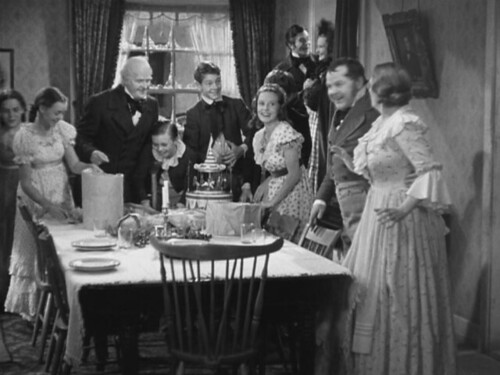
In the words of Tiny Tim:
“To all of us, everywhere, a Merry Christmas to all of us, my dears!”
“God bless us, everyone."
Images from MGM's 1938 A Christmas Carol -Editor
For more information about the film, see:
A CHRISTMAS CAROL is a Christmas Classic (MGM 1938)
(https://crackedrearviewer.wordpress.com/2015/12/23/a-christmas-carol-mgm-1938/)
